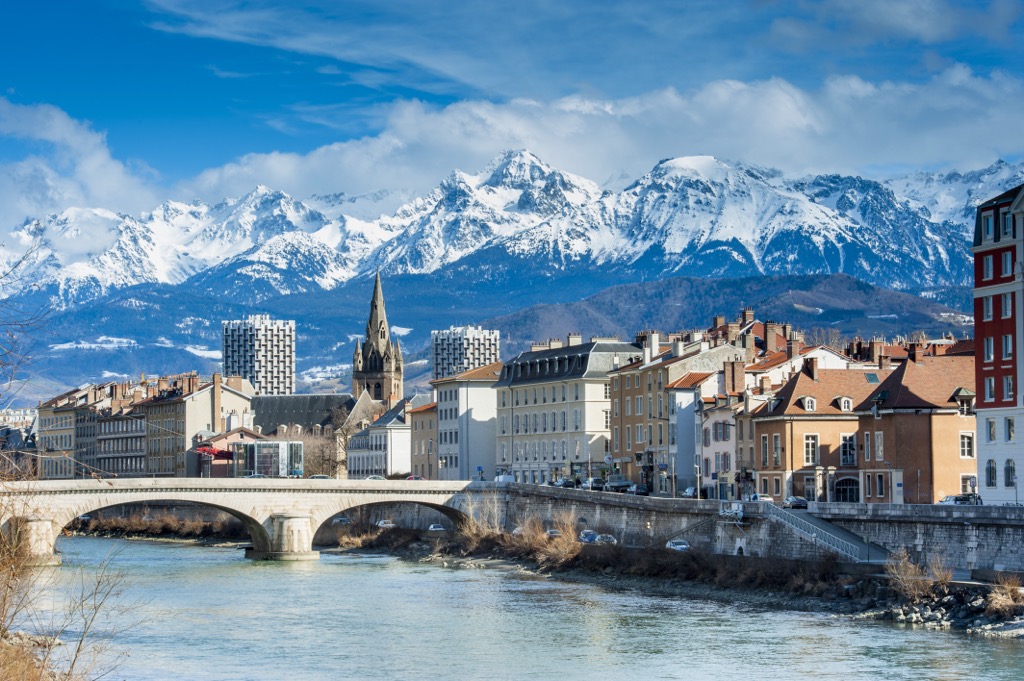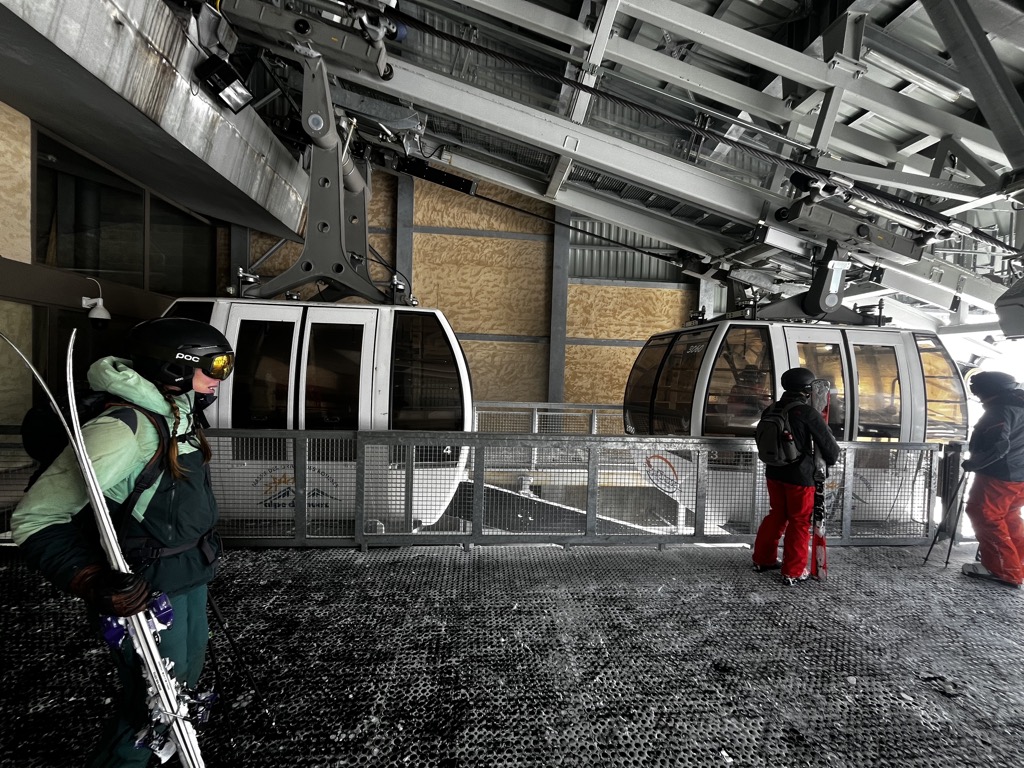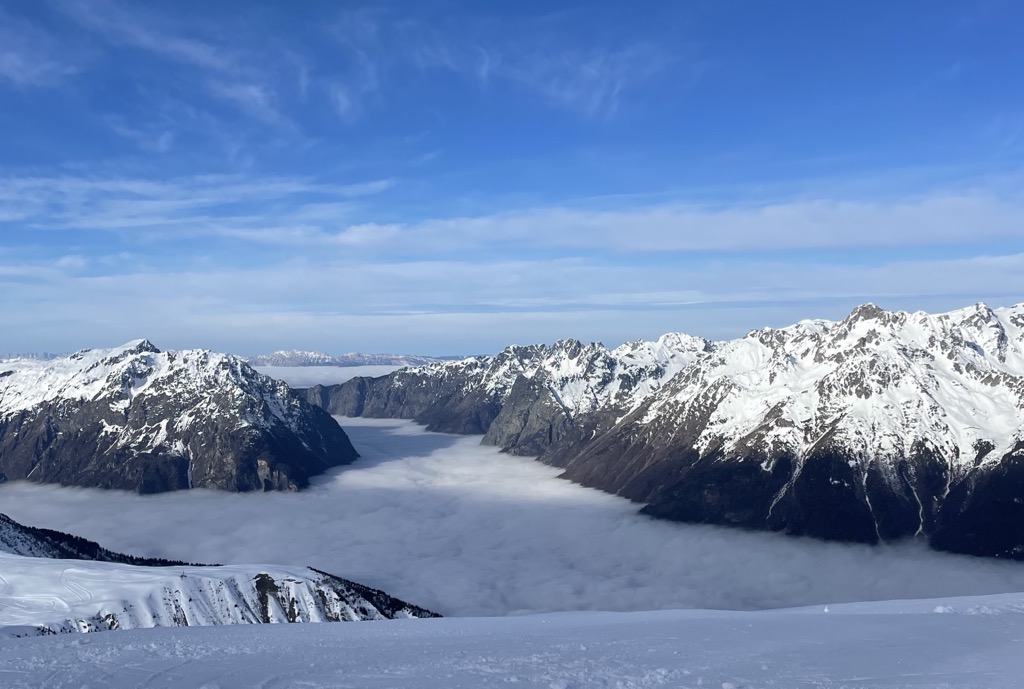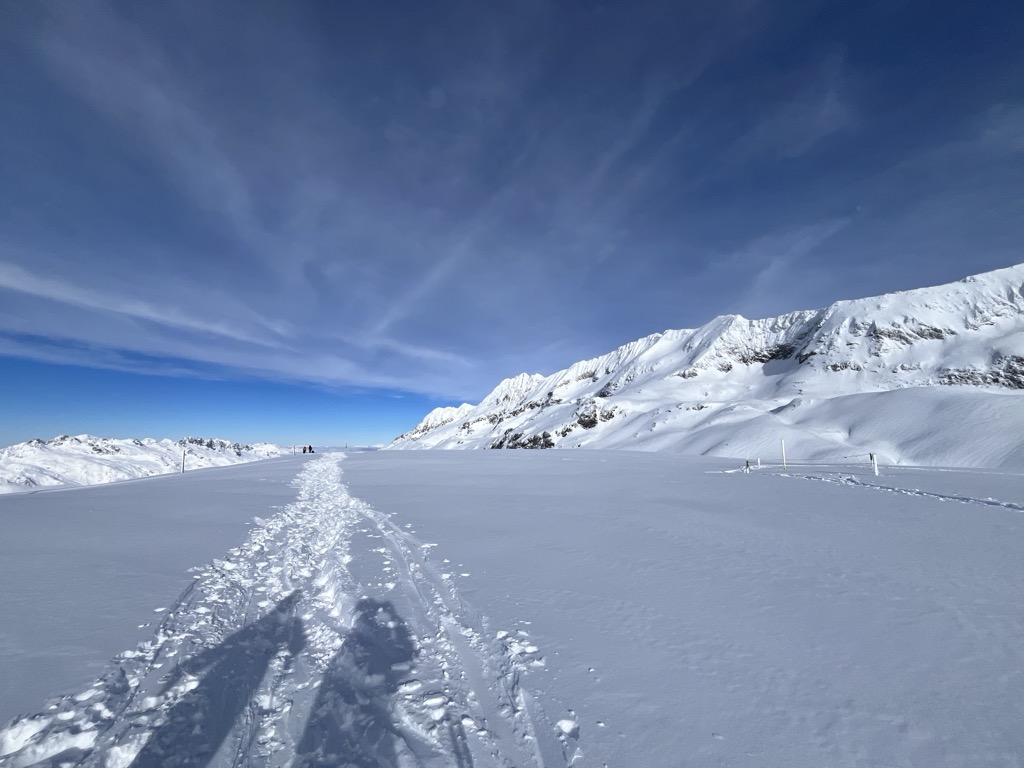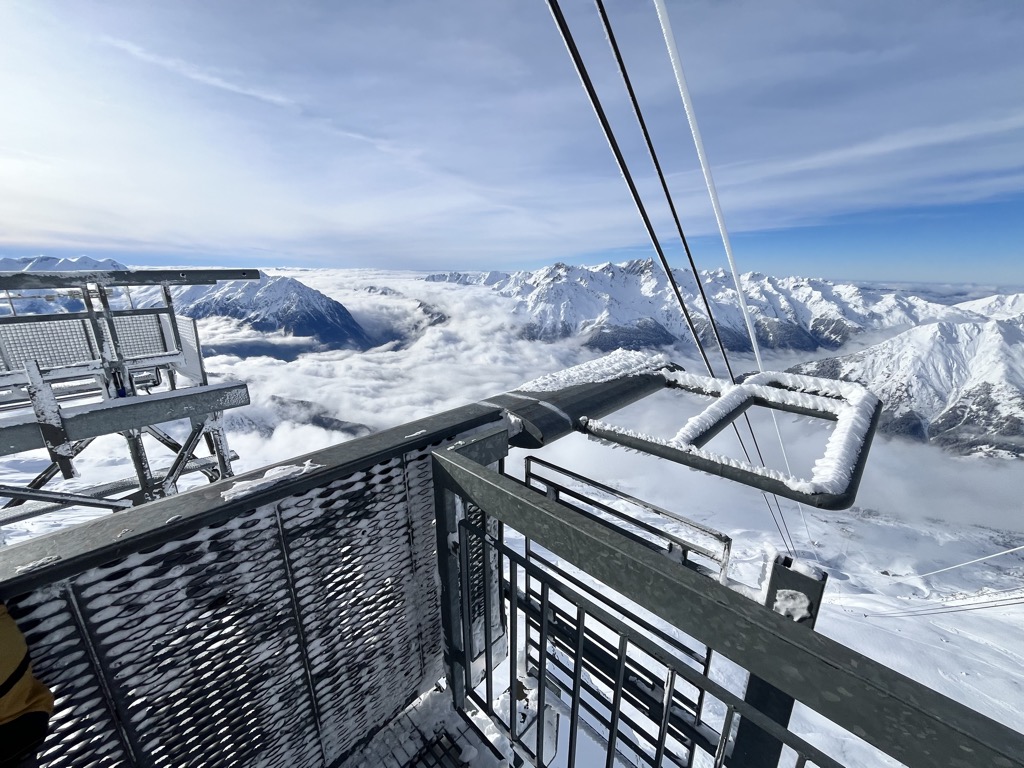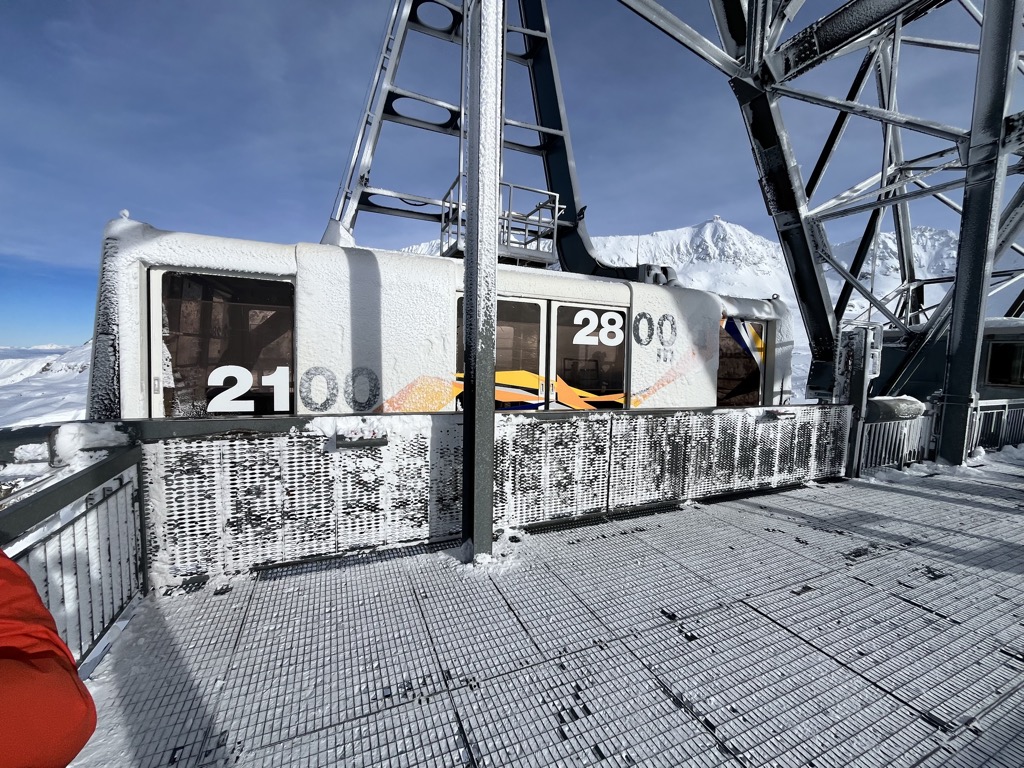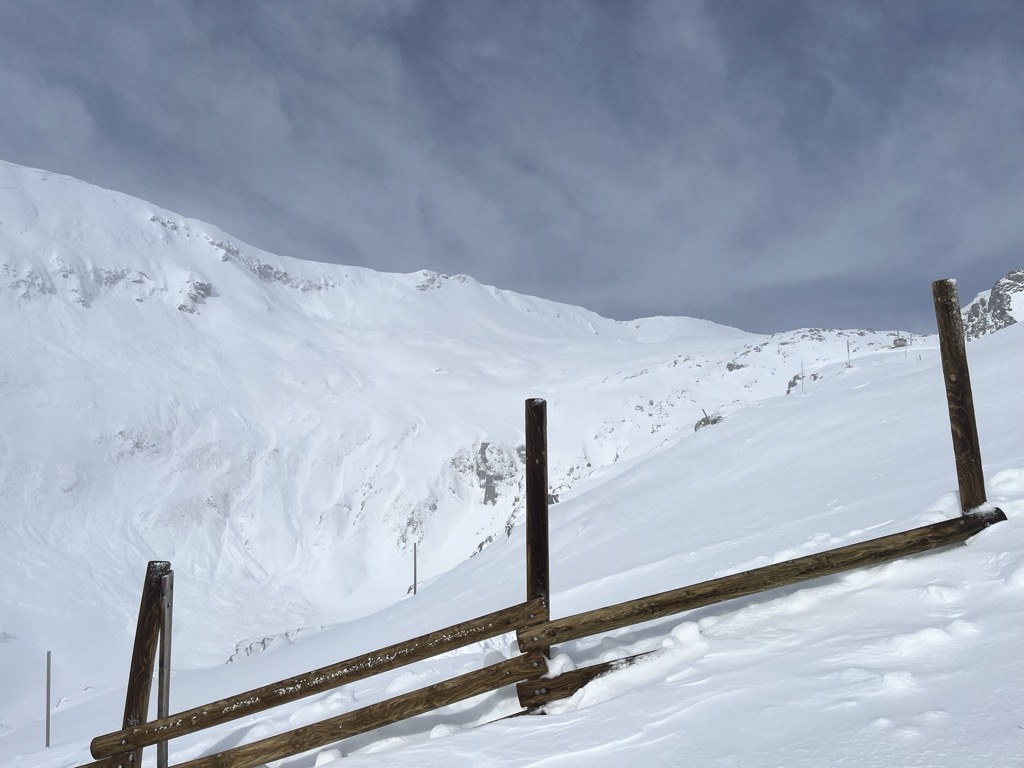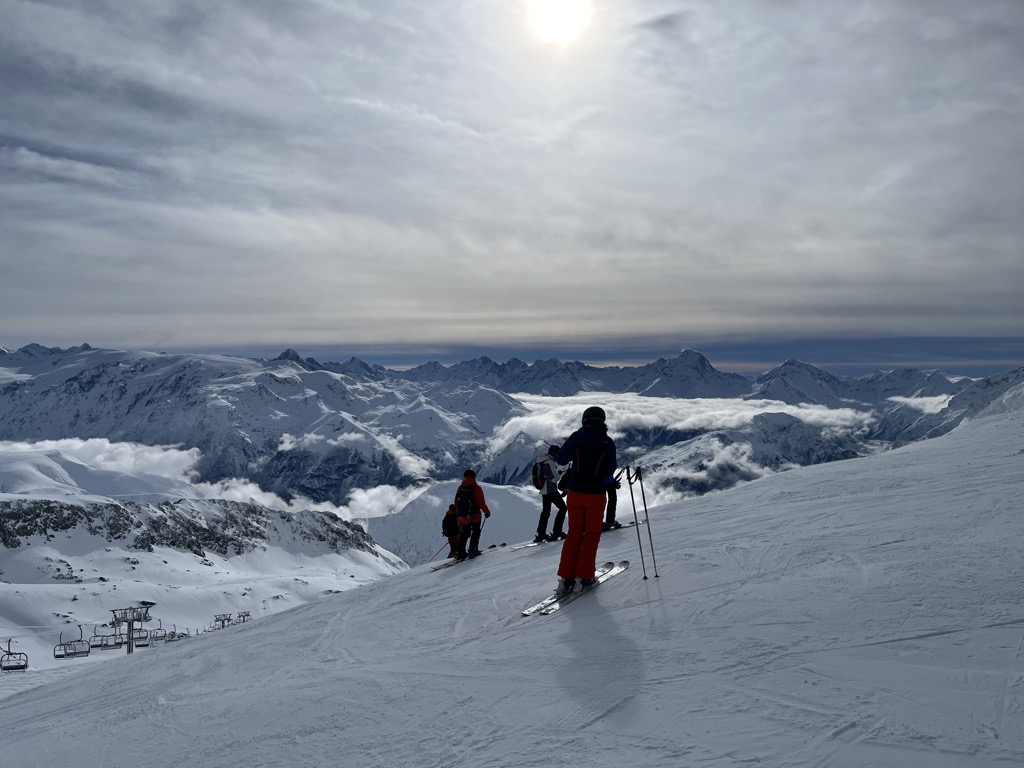Get PeakVisor App
Sign In
Search by GPS coordinates
- Latitude
- ° ' ''
- Longitude
- ° ' ''
- Units of Length
- Temperature

Yes
Cancel
Share ×

Scan the QR code and open PeakVisor on your phone
❤ Wishlist ×
Choose
Delete
Alpe d’Huez is a sprawling French ski resort located on the Grandes Rousses Massif in the Western Alps. The ski area, which has gradually expanded from the original purpose-built village of Alpe d’Huez, is now one of the world’s largest, with 249 km (155 mi) of pistes and an astonishing 236 square km (91 sq mi) of total skiable terrain. The off-piste terrain at Alpe d’Huez has always been legendary, even early in its history. However, the resort's southern exposure and mellow lower mountain feature scores of kilometers of easy and intermediate pistes, making it a popular getaway for those learning how to ski. Indeed, Alpe d’Huez is one of the world’s most versatile ski areas, where absolute beginners and the most daring extreme skiers can ride up the lift in the morning. Even the base villages, which range from the lively, purpose-built Alpe d’Huez village to the chic, ancient hamlet of Vaujany, are distinct and varied.
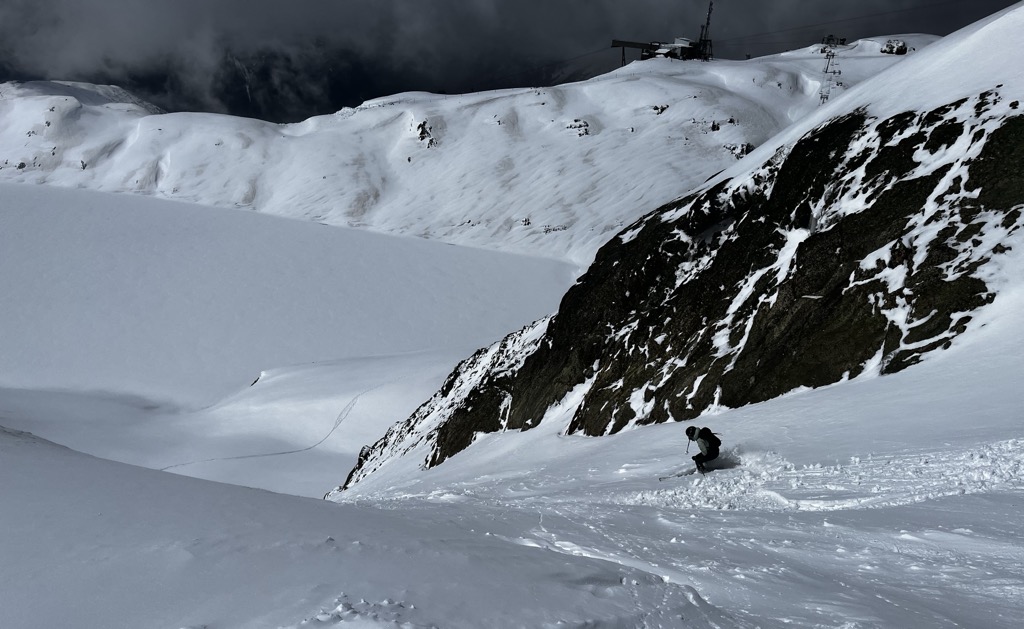
Alpe d’Huez Ski Resort spreads across several villages throughout the southern tip of the Grandes Rousses Massif. The nearest medium-sized city is Grenoble, while the closest town is Bourg-d’Oisans.
All lift-connected villages are accessible from the D1091 route, which cuts across the French Alps between Grenoble and Briançon. The main village, the eponymous Alpe d’Huez, is connected to the 1091 by the famous 21 switchbacks, often part of the Tour de France cycle race.
From Grenoble, the lift-connected villages of Allemond and Vaujany are the closest (and, in my opinion, the best base area of Alpe d’Huez). The Auris station is nearest from points east, i.e., Briançon.
For airports, the most convenient is Grenoble (1 hour drive), although they only offer decent flights within the E.U. For most people, the best access is Geneva, an international hub. You can get to Bourg d’Oisans from Geneva with just two buses: Geneva to Grenoble and then the LER 55 to Bourg. From there, a local bus will bring you up the hill.
You don’t need a car in Alpe d’Huez; lifts service everything, and the main village offers every kind of amenity. However, a car could be handy if you stay in one of the smaller villages.
Alpe d’Huez opens on the first weekend of December, and the lifts remain spinning until the second to last weekend of April. Despite its predominantly southerly exposure, the resort receives plenty of snow, and the skiing can often be excellent from the beginning to the end of the season.
Alpe d’Huez is one of the highest resorts in the Alps, with the Pic Blanc top station sitting at 3,330 m (10,925 ft). The Sarenne Glacier once covered the upper portion of the resort, and the lifts ran for summer skiing as well. Now, nearly all of the Sarenne has disappeared (although, to my surprise, I could spot a few debris-covered remnants of ice deep in the recesses of the bowl last summer while mountain biking).
Due to the southerly exposure, coverage can be limited on the resort’s lower slopes even though the terrain is mostly above 1600 m (5249 ft). Grass can often show on the off-piste sections during dry spells. However, the resort maintains excellent snowmaking capabilities; the necessary pistes are always covered throughout the season.
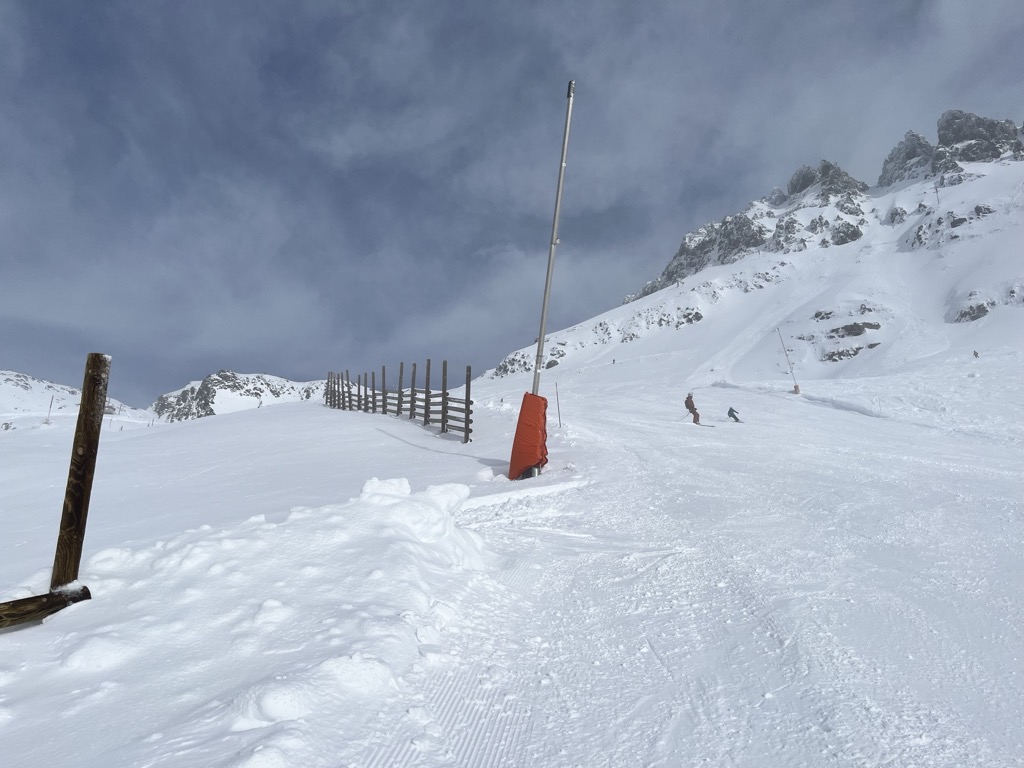
Alpe d’Huez and the Grandes Rousses Massif sit at the western edge of the French Alps. That means the range is one of the first to be hit by storms from the Atlantic Ocean, the predominant winter storm track. The upper mountain often resembles an ice cream cone with rocks buried beneath meters of snowpack. In 2024, ski patrol reported a base of five meters (16.5 ft) by early March at the top of the Pic Blanc.
On the other hand, Alpe d’Huez also gets quite a bit of sun. The southerly exposure comes with pros and cons from the perspective of a prospective skier or rider. There’s no doubt that powder snow does not stick around as well at Alpe d’Huez, even with the high elevation, as it does at north-facing ski resorts. Meanwhile, the pistes and vast off-piste terrain soak up the sun all winter and can get soft and spring-like when north-facing resorts are cold and icy.
Another thing to consider is Alpe d’Huez’s alpine nature. The resort is nearly entirely above treeline, contributing to its epic character but also making for brutal conditions during bad weather. Trying to ski here during a whiteout can be a miserable experience that can result in injury. Just this past year, a friend tore multiple ligaments on her knee while navigating the snowfields in low visibility.
I’ve skied at Alpe d’Huez at some point during every month of the season, so let’s dive into the conditions during different times of the season.
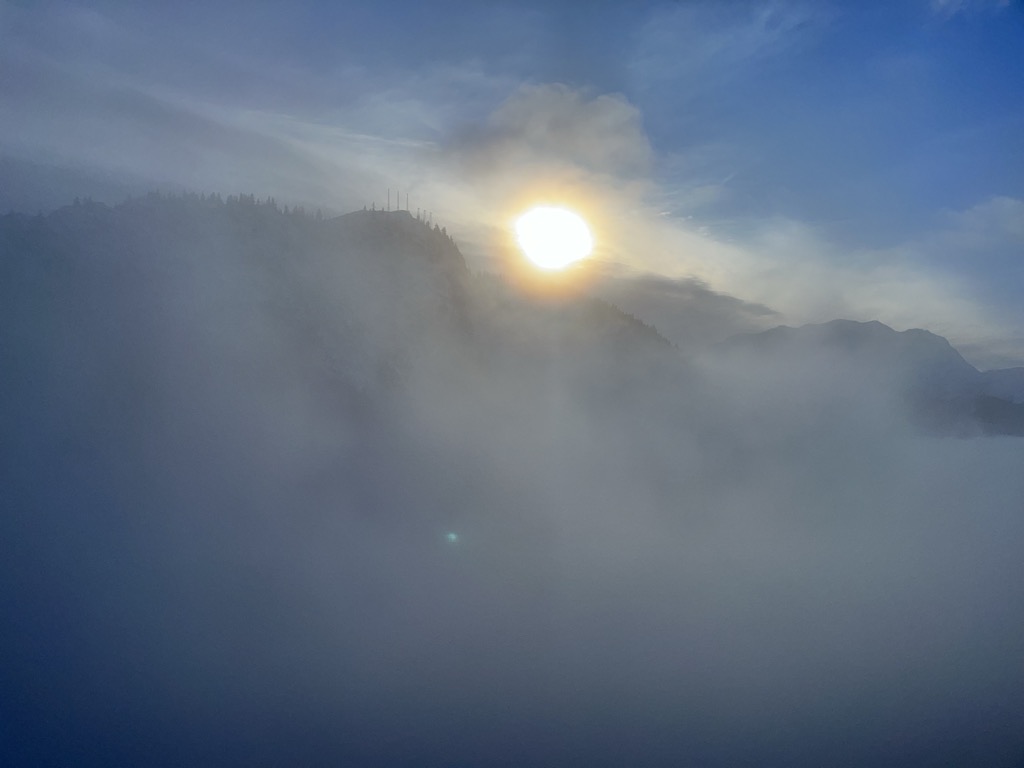
Like nearly all Northern Hemisphere ski resorts, Alpe d’Huez is hit or miss during December. However, the Alps tend to do alright during December, even during bad seasons. For example, 2021-22 saw a banner start to the season in the first half of December, with at least half a dozen big powder days and cold temperatures. If you were a local sticking around for the rest of the season, those might have been your best days because the remainder of winter was nearly non-existent, and the Alps recorded one of its driest spells on record.
December 2023 was also supremely deep, with excellent powder days and the entire mountain’s terrain skiable by opening day (the second half of December, however, was dry and uneventful). The rest of the season also received a lot of precipitation but with warmer temperatures.
In addition to the favorable storm track, December has a low sun angle, allowing the snow to stay a bit fresher after a storm. With a bit of luck, conditions will remain soft for days after a storm. Unfortunately, the winters are getting warmer and warmer, resulting in an icier Alpe d’Huez.
December is also relatively uncrowded, a definite advantage in a resort that regularly hosts more than 20,000 skiers per day. Yup, that’s right. They call these purpose-built French resorts “megaresorts” for a reason. The scale of the crowds and the infrastructure required to handle them are impressive.
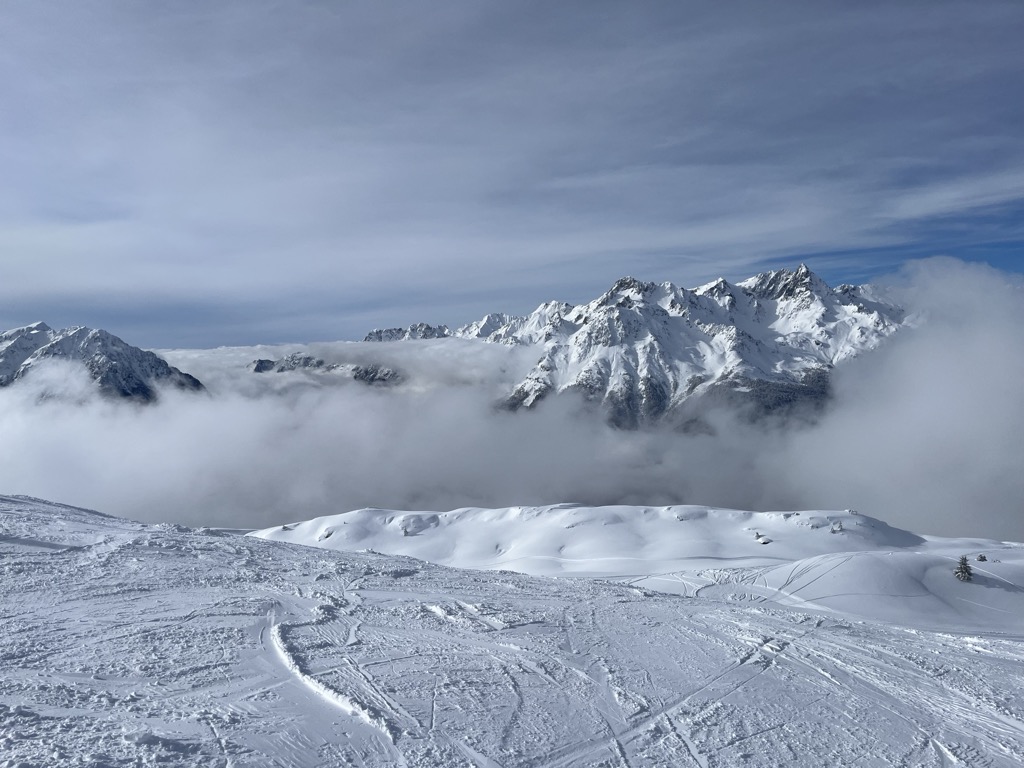
Mid-winter in Alpe d’Huez can offer a respite from the cold, shadowy recesses of other ski resorts in the Alps. When the sun is out, the slopes can feel like an entirely different season than others in the range. In fact, I’ve had full-on spring skiing here in mid-winter, and this is only happening more and more often. You can also have big powder days during this time, and it’s the most likely period to get days with light “blower” powder.
Plus, the base depth is likely to be well-established at this time of the season, and there will be more chances to explore the off-piste zones.
One thing to be aware of skiing at Alpe d’Huez in February is the French vacation. All resorts see increased skier traffic, but it’s particularly awful here. You can be guaranteed to experience massive crowds. However, impressively, lift lines aren’t much of a problem because the infrastructure is so efficient (a mindblowing capacity of 95,000 skiers per hour). Still, for me, it’s just exhausting to have so many people surrounding me all the time.
Another issue I’ve experienced here is that the pistes can be super icy for weeks at a time during mid-winter dry spells. In addition to jostling around for a place in one of the many cable cars, you’re skidding your way down scraped-off pistes, trying to avoid the hundreds of other people surrounding you. Indeed, piste skiing here can be like a perverse human slalom event.
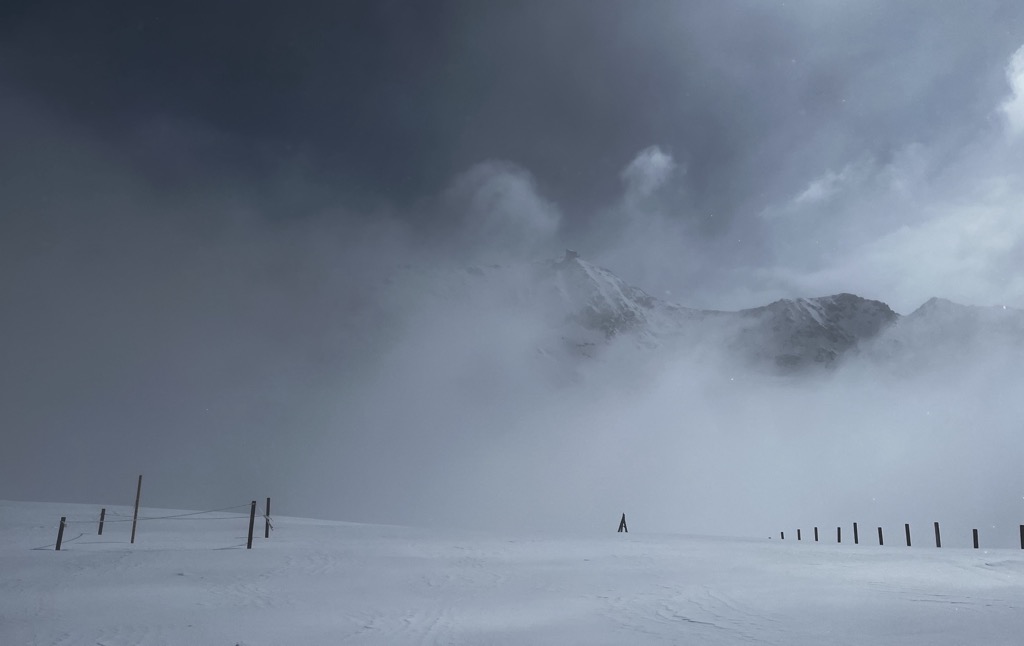
March is the quintessential month to ski in the French Alps. If you come to Alpe d’Huez, expect a sun-drenched vacation with a possible powder day or two. March is statistically the snowiest month but the sun is also super powerful by this time. Cold snow can still last a while, especially on the Vaujany side and off the Pic Blanc lift. However, a few warm sunny days can quickly turn the mountain into a spring playground. Base coverage is generally as good as it will get in the season.
Although it only pertains to a few dedicated and experienced backcountry skiers, March is the best month to ski the signature descents off the Pic Blanc, such as the Pyramid.
As mentioned, Alpe d’Huez is south-facing, so the snow can quickly transform, even when temperatures aren’t that high. On a recent March powder day, we had cold, dry snow in the morning. By the afternoon, the new snow had turned to a sticky mush just from the sun, even though the temperatures on the upper mountain remained below freezing.
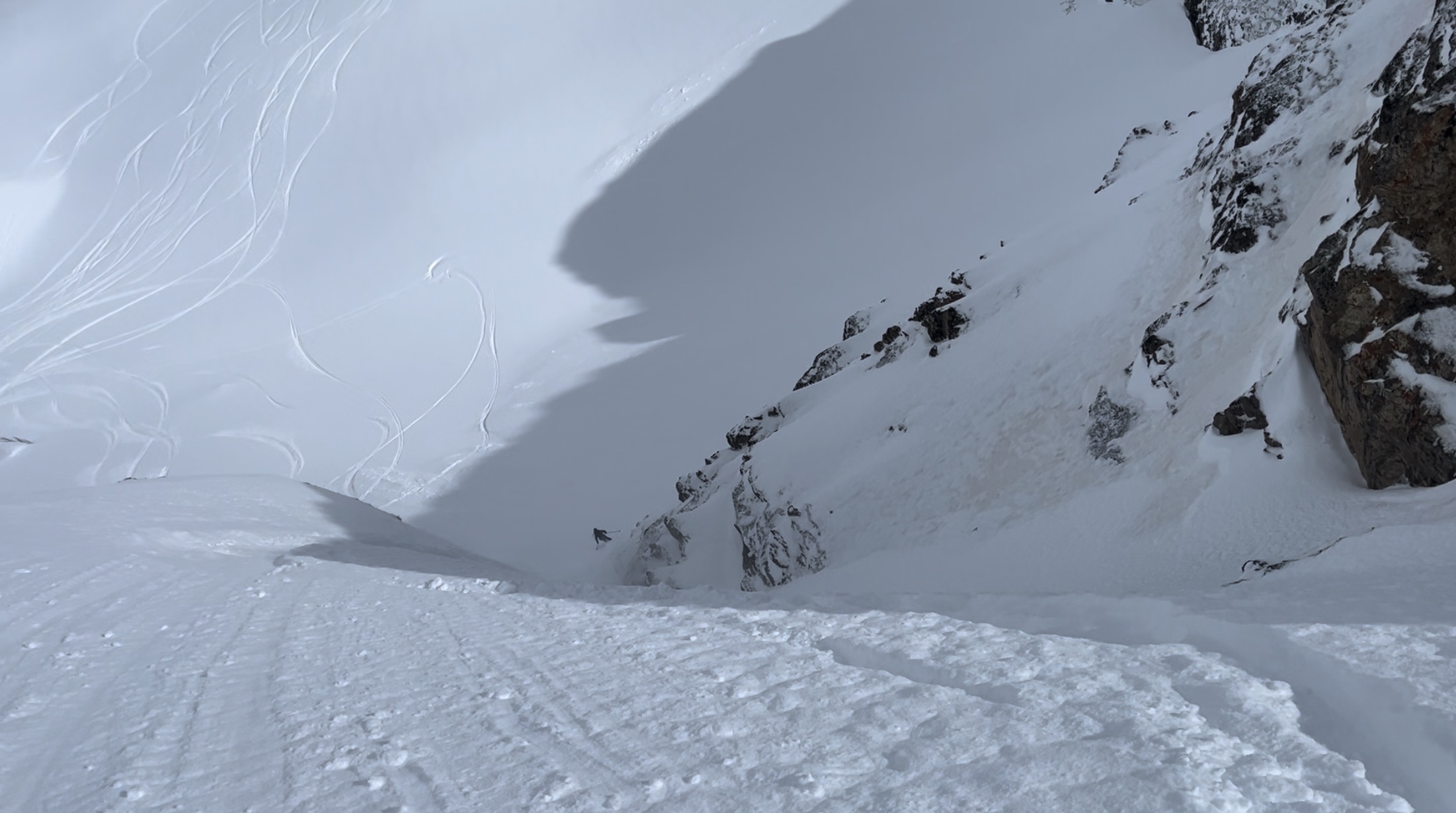
April is full-on spring skiing in Alpe d’Huez, with soft conditions on and off-piste throughout the mountain. In recent years, the base has no longer been skiable by this time, requiring an upload and download from one of the lifts or a crowded, slushy ride down one of the remaining strips of snow.
Don’t forget to wear sunscreen because the south-facing April sun reflecting off the snow will seriously damage your skin.
It’s not all spring t-shirt skiing in April, though. If it gets cold following warm weather, the mountain can turn into a sheet of ice. The Alps can also get dumped on in spring, but I’ve found that the snow at Alpe d’Huez turns to elephant snot (extremely dense, heavy powder) as soon as the sun hits it, even when it’s cold.
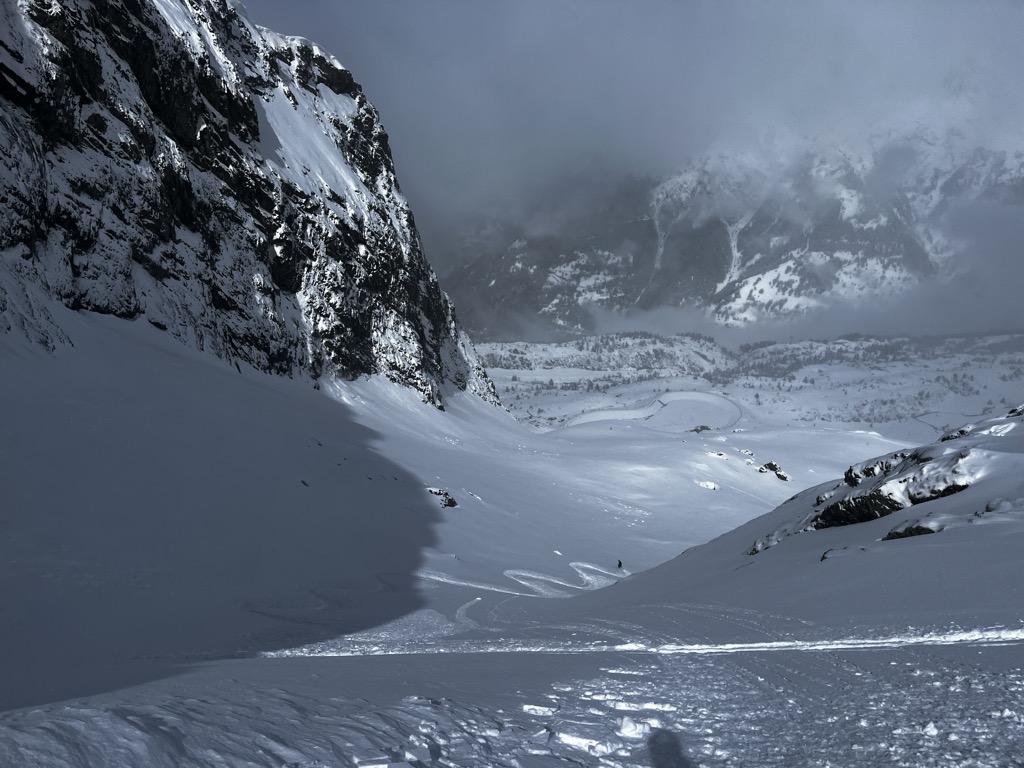
Alpe d’Huez is one of the biggest resorts in the world, and navigating it without a map can be a nightmare. One of the biggest issues is missing your connecting lift and getting stuck in the wrong base village. I know many people who have experienced this in both winter and summer and a thriving taxi business is based on these mishaps.
The resort's website provides a detailed map. I’m usually not the biggest fan of these maps, but this one actually gives some idea of the mountain’s true character.
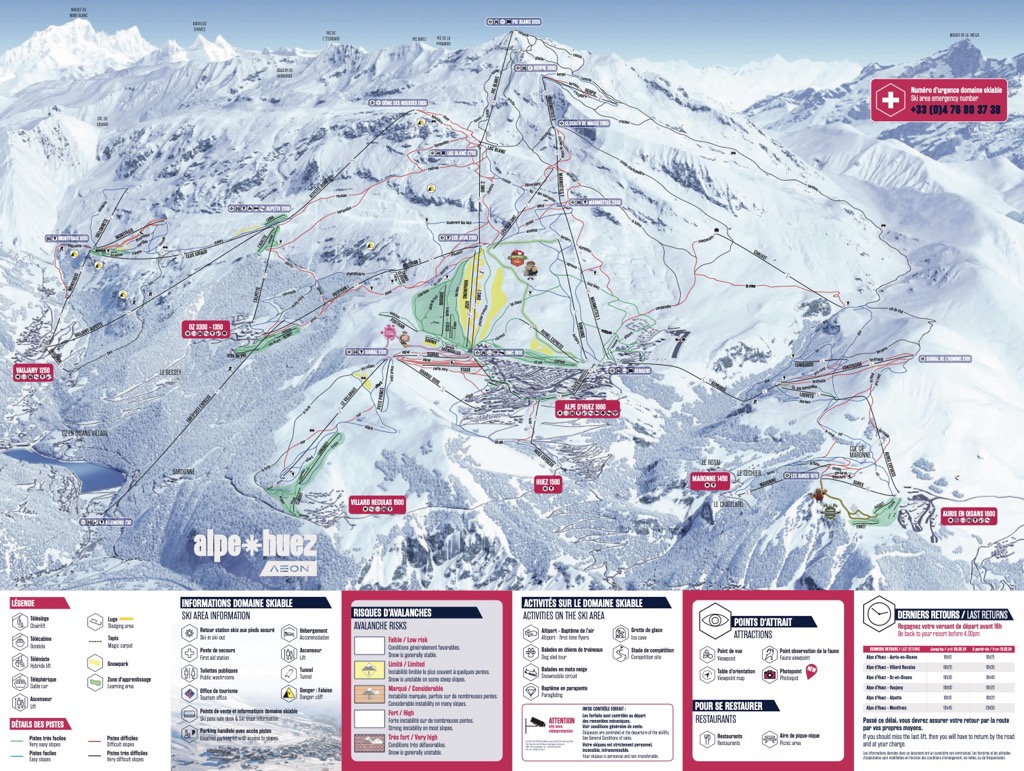
However, the best way to discover Alpe d’Huez is undoubtedly through the PeakVisor mobile app. The app offers an interactive version of the mountain that you can reference at any time, whether you want to know when a lift closes, where a trail goes, or what the surrounding off-piste might look like.
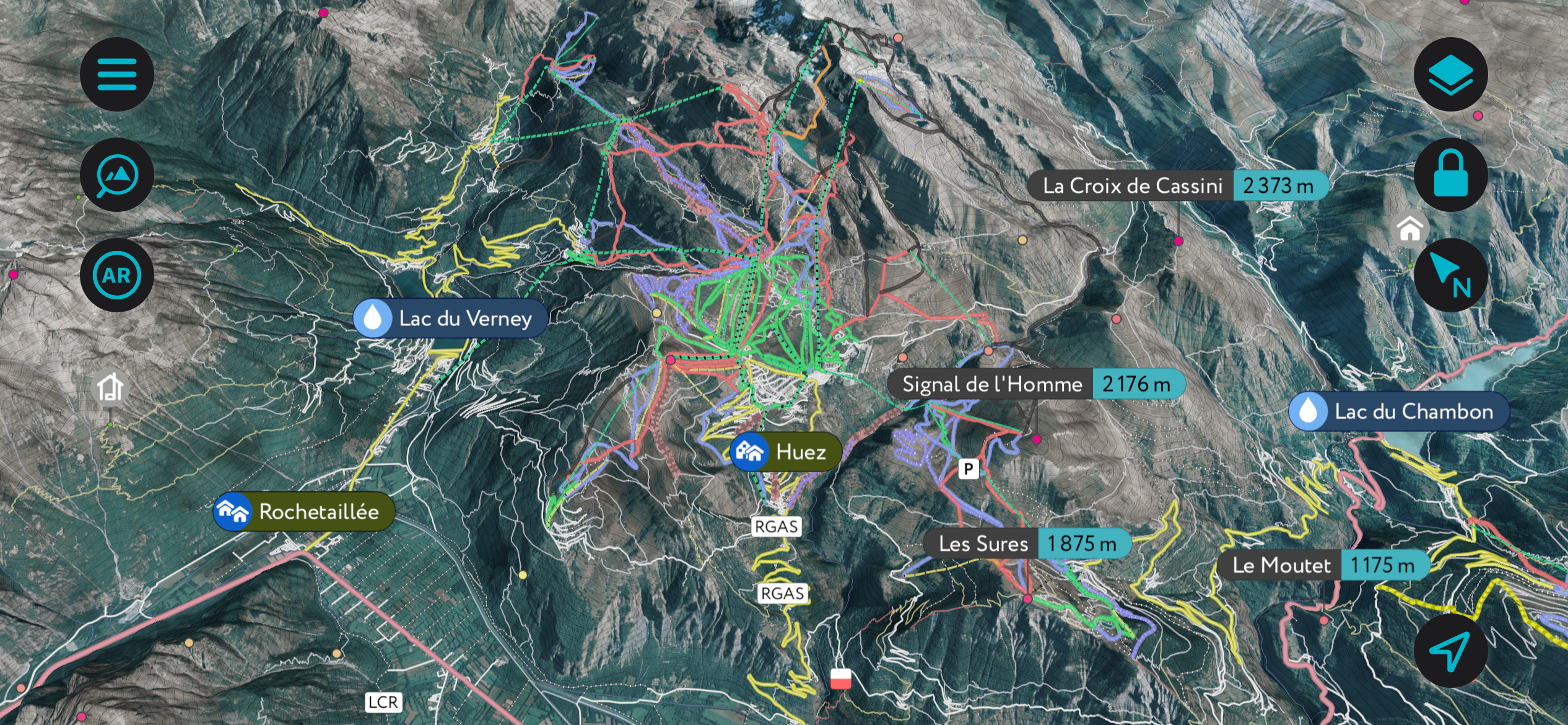
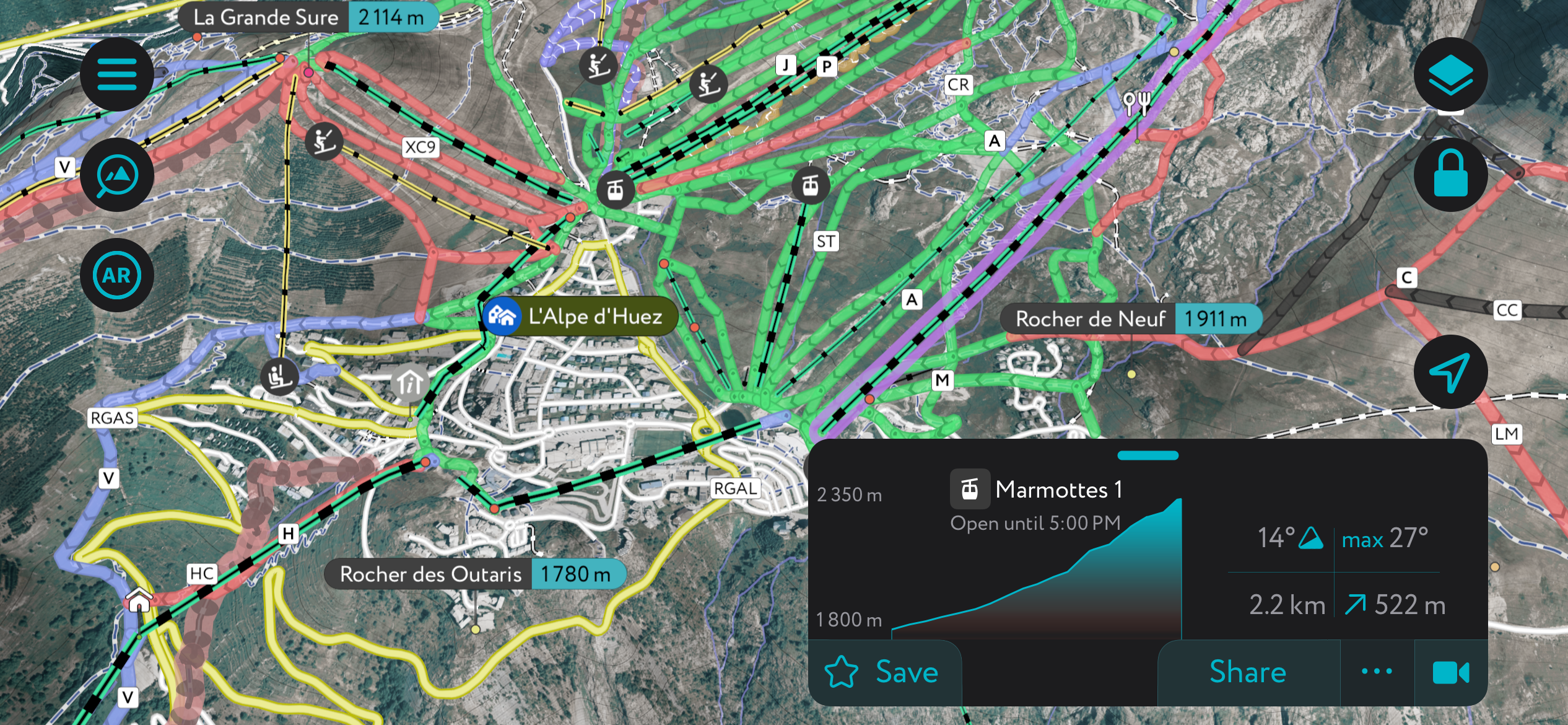
I’ll quickly gloss over the mountain’s layout to give our readers the lay of the land, then go into more detail on specific lifts and terrain in the next section.
The beating heart of the resort was constructed throughout the 60s, 70s, and 80s. The village is a bit tasteless, but the mountains are beautiful, and you can find everything you need here. It may not look that good, but it works. As the French say, sa marche.
Plus, the access is excellent, better than anywhere else on the mountain. Two central lift systems take skiers to the resort’s highest points. First, you’ve got the Marmottes, broken into three stages. The top is a large cable car that takes you to 3060 m (10,039 ft), giving you access to some of the better terrain on the mountain (just check out the steep couloirs directly under the lift).
Naturally, you also have the DMC Gondola, which travels to the base of the Pic Blanc cable car. It’s separated by a mid-station that deposits skiers on the frontside’s easiest pistes.
At least ten other small lifts access mainly short beginner and intermediate slopes, with a few red trails thrown in on the signal side.
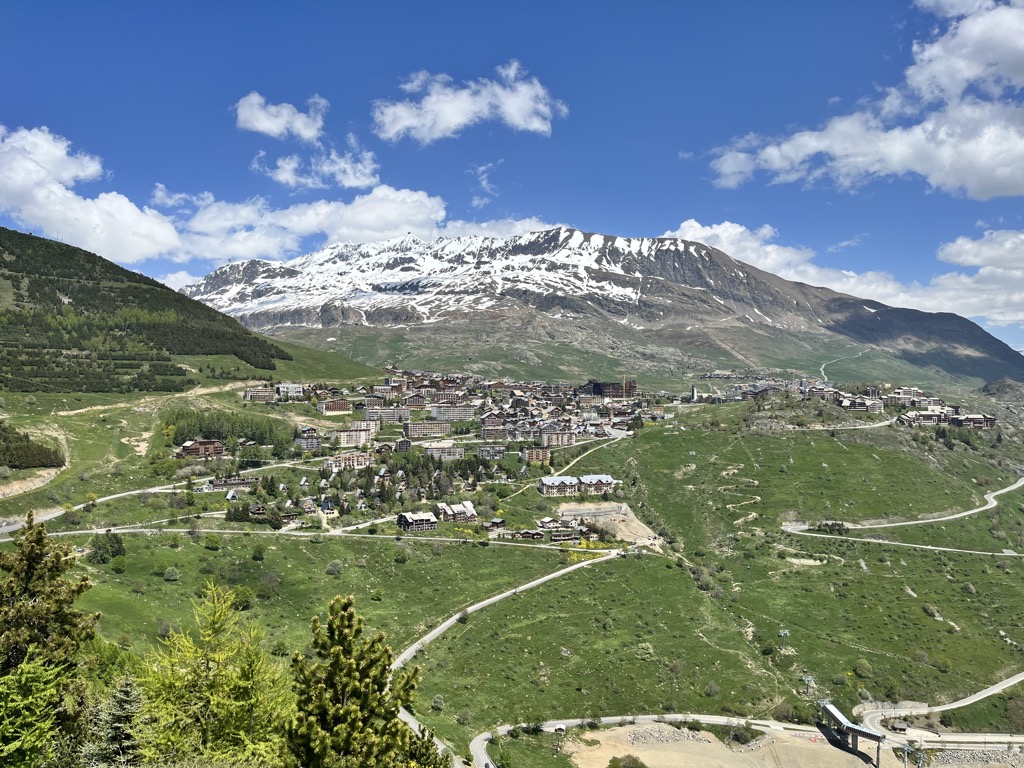
Huez is the original village of the mountain. Here’s a bit of history: back in the day, many French alpine villages had a sort of land claim for access to the slopes above their village during the summer. The locals would use the land almost exclusively to graze livestock. These areas were referred to as the “Alpe” of the village. Thus, the summer grazing slopes of Huez were known as the “Alpe d’Huez” long before any ski resort existed. The resort just borrowed the name. And, in case you were wondering, they still graze animals in the summer. Lots of them. And they love pooping on the mountain biking trails.
Huez isn’t the prettiest village in the Alps, but it’s far more pleasing to the eye than Alpe d’Huez. Unfortunately, it requires two lifts to get to the base area each morning, which makes it slightly less convenient.
Located at 730 m (2,395 ft), Allemond rarely gets much snow. There’s not too much noteworthy about the town, except the excellent parking and lift access. If you want to live in Alpe d’Huez permanently, Allemond and Vaujany are the best villages, but they aren't ideal if you want to experience the buzz of a ski resort.
From Grenoble, the direction most people will be coming from, you can get here much faster than the Alpe d’Huez base village. Moreover, there are only two lifts to reach the DMC mid-station.
The only problem is that because it doesn’t snow here and there are no trails to the bottom of the mountain, you have to download before the lift closes at the end of the day. As I’ve mentioned, there’s already a thriving taxi business based on this. It’s a pretty penny for a ride, likely 100 euros, so don’t park here if you plan to hit the bars after skiing.
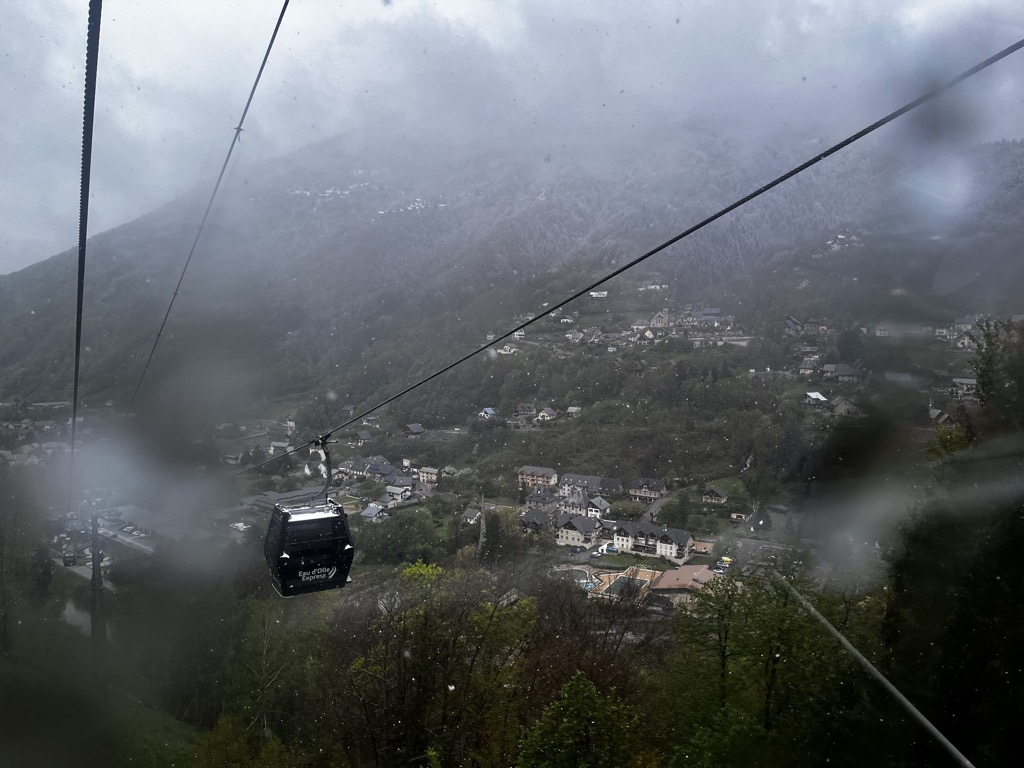
The village of Vaujany is the finest in the Alpe d’Huez collection and is located further down the valley from Allemond. It’s tasteful and chic and also offers some of the best access at Alpe d’Huez. Two quick cable cars and a short traverse will take you to the base of the Pic Blanc cable car. Some of the best off-piste in the resort is off the Alpette-Rousses.
Vaujany has a ski run returning to the village, so you can ski home at the end of the day. The village sits in a deep valley at 1250 m (4,101 ft), once high enough to retain plenty of snow throughout the winter. The times have changed, however, and even during snowy seasons (like 2024), the run is melted out much of the winter. Make sure you don’t miss that cable car back at the end of the day because the taxi ride here will be even more expensive than Allemond.
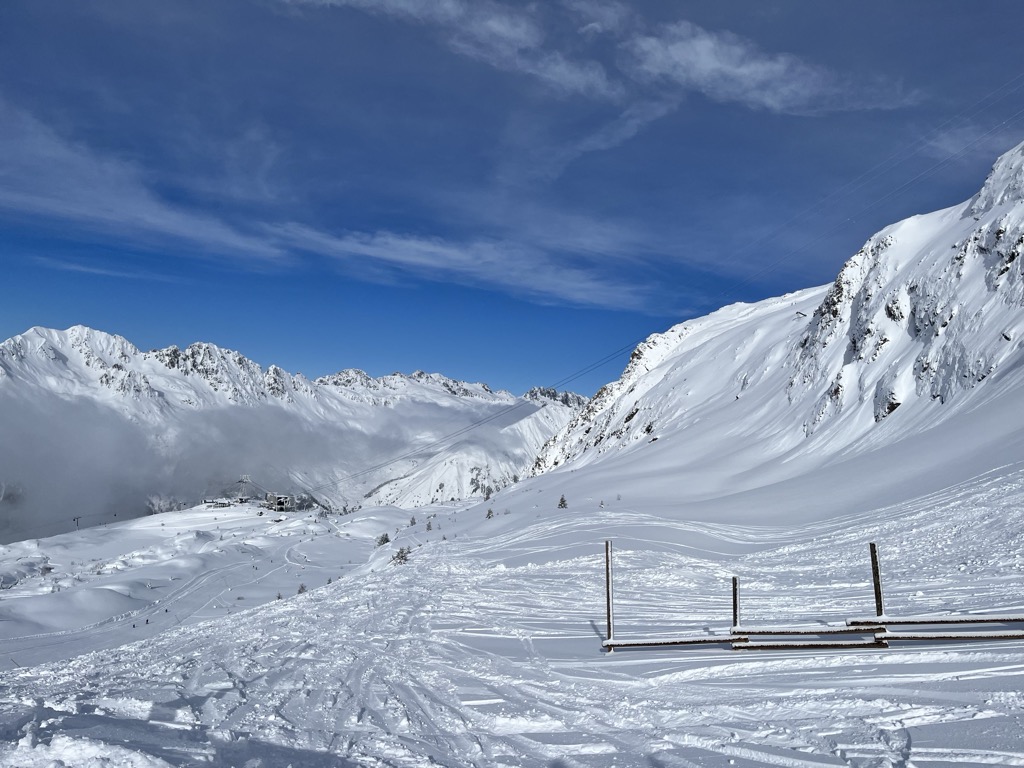
Auris is the best access to Alpe d’Huez from the east if you want to eliminate drive time. However, you’ll have to ride a couple of long lifts to reach the main village; it takes about 30 minutes in total. The village is otherwise uninspiring, as it’s not much more than a collection of ugly high-rise condos.
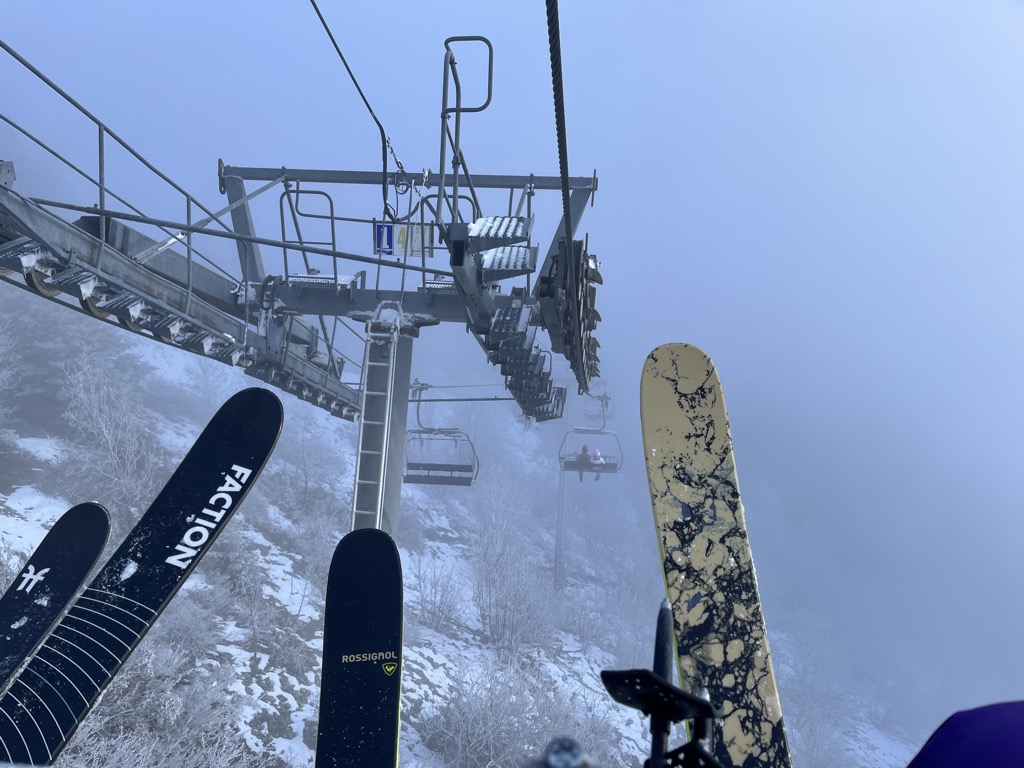
Villard Reculas is one of the more secluded villages on the resort. You could easily spend a week at Alpe d’Huez and never venture here. It’s beautiful, perched on the steep mountainside above Bourg d’Oisans. The access is alright, with one lift that returns you to the Signal, where you can easily ski to Alpe d’Huez. However, there’s not much going on here; it’s really just a collection of expensive-looking second homes.
Alpe d’Huez offers excellent ski terrain and lift access. This makes up for the negative aspects of the resort, like the south aspect, poor visibility with clouds and storms, and sometimes horrendous snow conditions. There are 84 lifts, so we won’t go into detail on all of them, but let’s break down the best ones to help you find where you need to go on the mountain.
Like many of the best ski mountains, Alpe d’Huez is shaped like a Hershey’s Kiss. That means most steeps are at the top, and the green runs are all at the bottom, near the village. This natural feature of the mountain really lends itself to good filtration between beginners and experts, so these two demographics don’t get in each other's way.
Another thing to note is that intermediate skiers can ride essentially every lift on the mountain and have a route to return on. The exception is the Pic Blanc, where only black trails descend. The famous Sarenne descent, one of the longest pistes in the world, is black, but it’s not terribly hard. Instead, the hardest part is avoiding the other (bad) skiers on the slope.
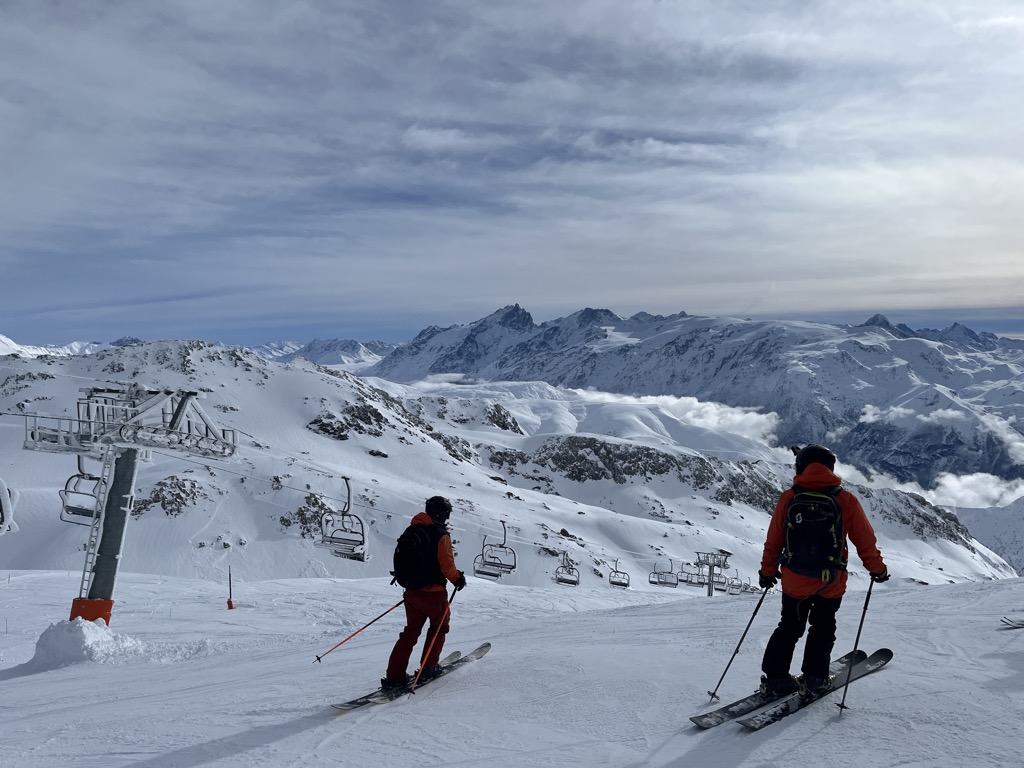
Marmottes is one of two main arteries heading to the upper mountain. It’s a series of three lifts, with the final stage being a tram to 3060 m (10,039 ft). You can get off at any of the stages. The first station, Marmottes 2300, is excellent for beginners and intermediates. It’s also the location of La Folie Douce, which has become a phenomenon at French ski resorts.
The second stage offers more red and black pistes for advanced skiers. Off-piste terrain is also scattered between the pistes.
The third stage takes skiers and riders up to a ridge. You drop off the backside into the Herpie zone, one of my favorites on the mountain. There are a few pistes of varying difficulty, but in between, you’ve got vast tracts of playful, low-angle off-piste. Doing five or even ten laps on the Herpie lift is easy. If there are not many people, you can find fresh pockets right under the lift until well into the afternoon.
Because it’s high, the snow conditions here stay soft as long as temperatures are reasonably cold. However, it is quite south-facing, so things deteriorate if it’s warm or sunny.
The Herpie is the only lift you can run laps on at altitude. The Glacier lift used to service the very upper mountain between the top of the Herpie and the Pic Blanc, but it was dismantled in 2023. To descend from the base of the lift, follow the Sarenne down to the base area. Otherwise, you have to download the Marmottes III cable car.
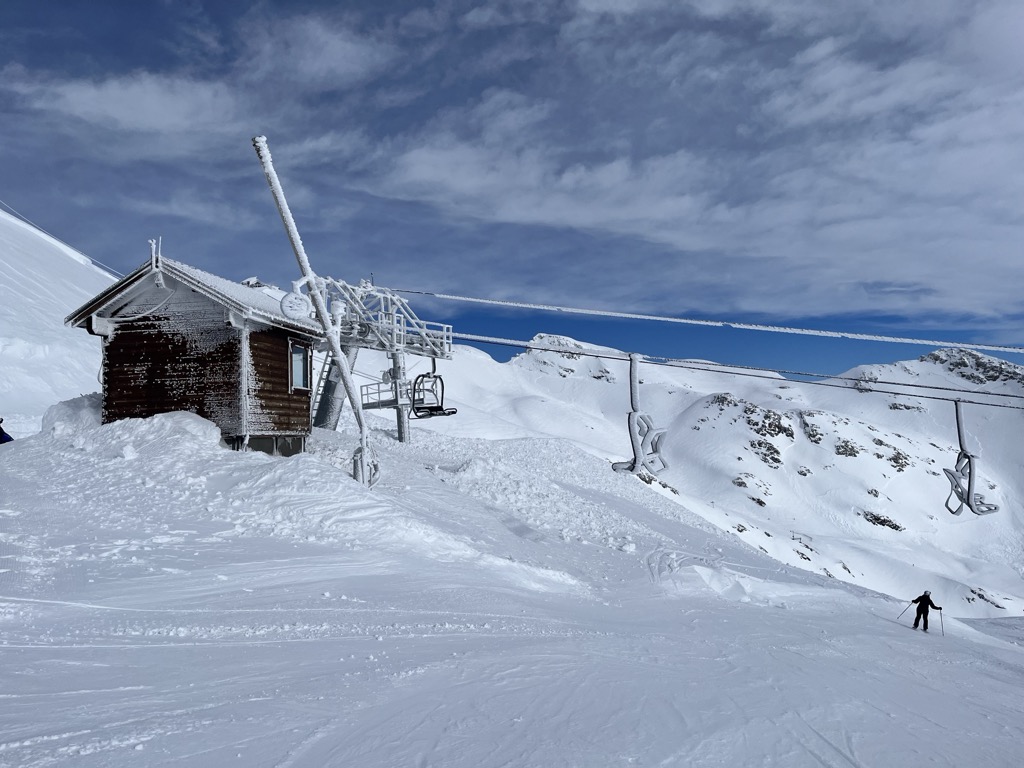
You can’t ski down the frontside from the Marmottes because the only two routes are two very steep couloirs called the Cheminèes des Mascle. With a decent snowpack, they do pass, and it’s possible to ski them. But they are very serious, even for expert skiers. Because they’re south-facing, they can often get icy; finding the right conditions is challenging.
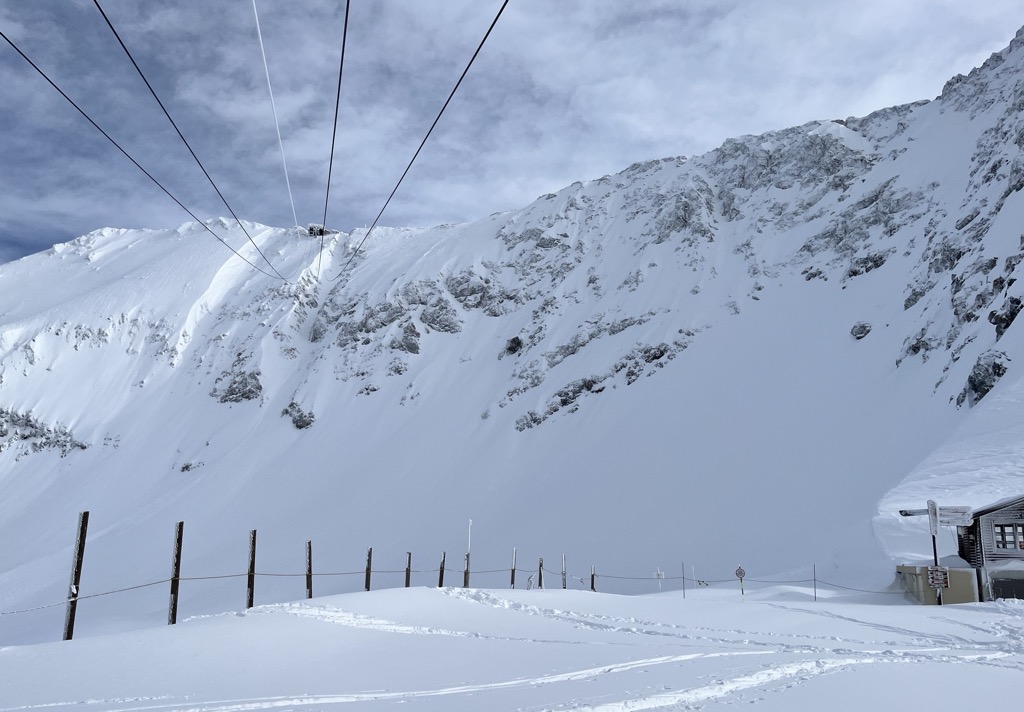
The DMC / Pic Blanc lifts are the second main artery to the upper terrain. The infamous Pic Blanc lift brings you to the tippy top of the Pic Blanc, where you’ve got some of the best descents in the Alps at your fingertips.
Like any cable car bound to the heavens, the line at the Pic Blanc can get bad during the February vacation and powder days. On the other hand, it’s often wonderfully devoid of people, and you can run laps all day.
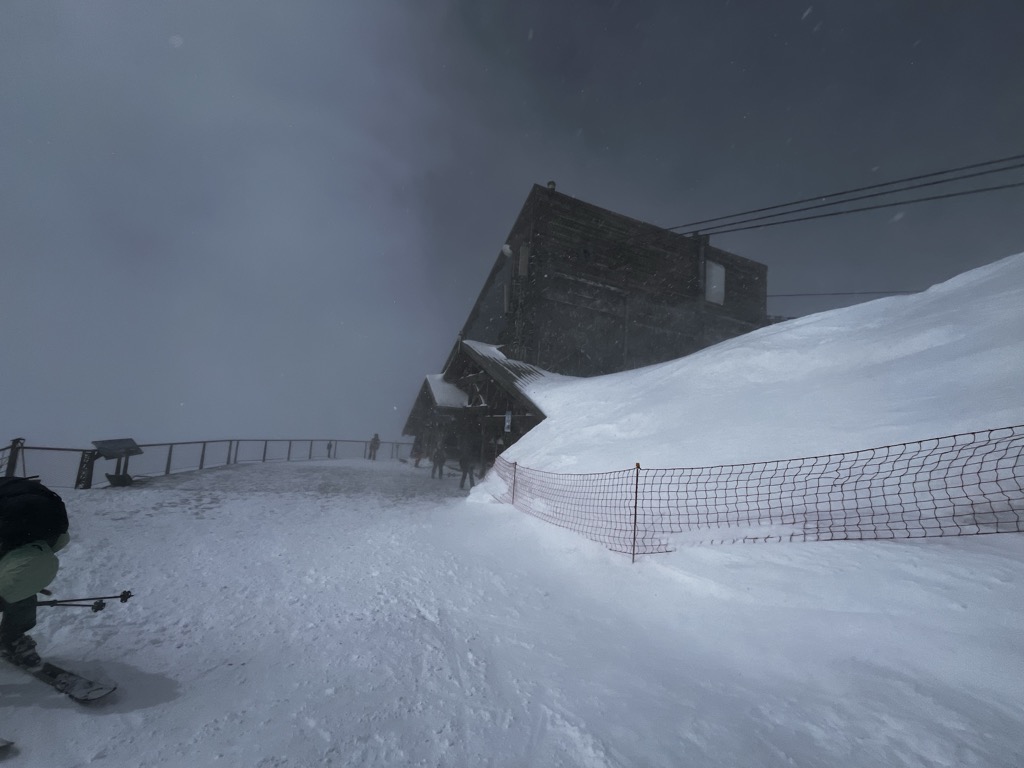
The Sarenne is the black piste snaking from the top of Pic Blanc at 3,330 meters (10,925 ft) to about 1650 meters (5,413 ft). It’s 16 kilometers (10 miles) long, making it the world’s longest black run, the second-longest groomed run, and the third-longest established descent (Chamonix’s Vallée Blanche is the longest). It’s a great run and a worthy representative of the repertoire of black pistes at Alpe d’Huez. However, my favorite part of the Sarenne is the short pitches of off-piste you can catch at the top. Traverse left off the cat track toward the top and choose your line; there’s plenty of space back here.
Unfortunately, you must ride several lifts to return to the Pic Blanc, so doing more than two or three Sarenne’s in a day is hard. Check out the Tunnel area if you want to lap the Pic Blanc.
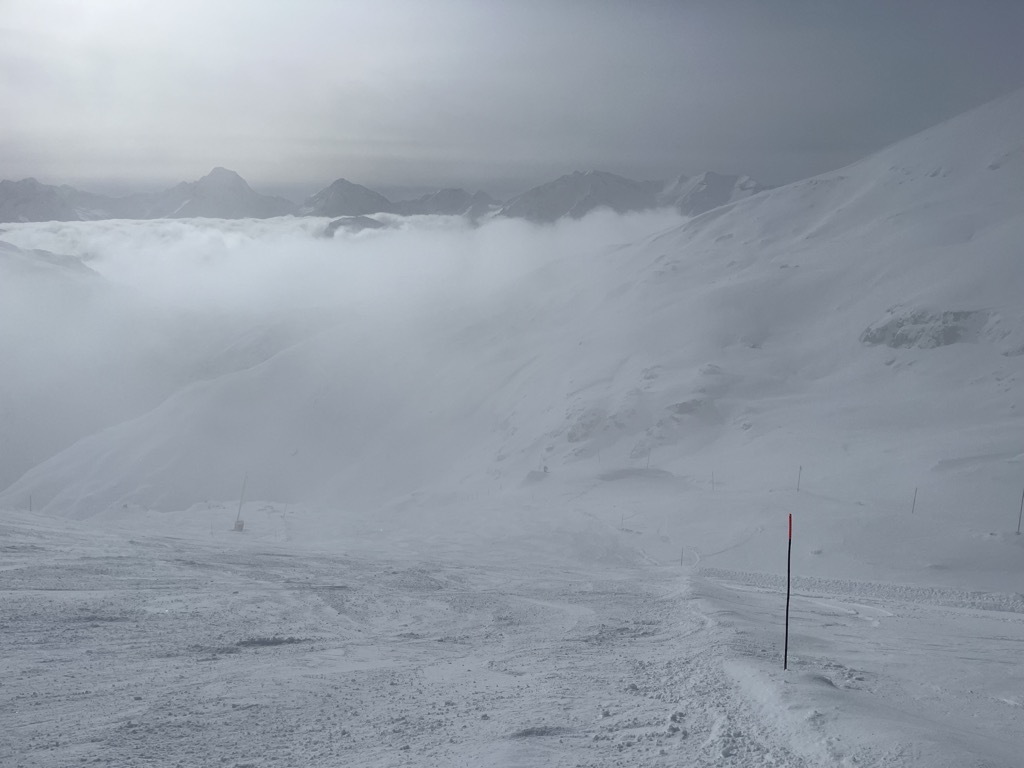
The Tunnel zone is basically the southwest face of Pic Blanc. You descend the “Glacier” piste (or off-piste) and cut through the mountain in a tunnel with a hilariously 80s vibe. It fits with the rest of Alpe d’Huez’s infrastructure: slightly outdated but superbly efficient.
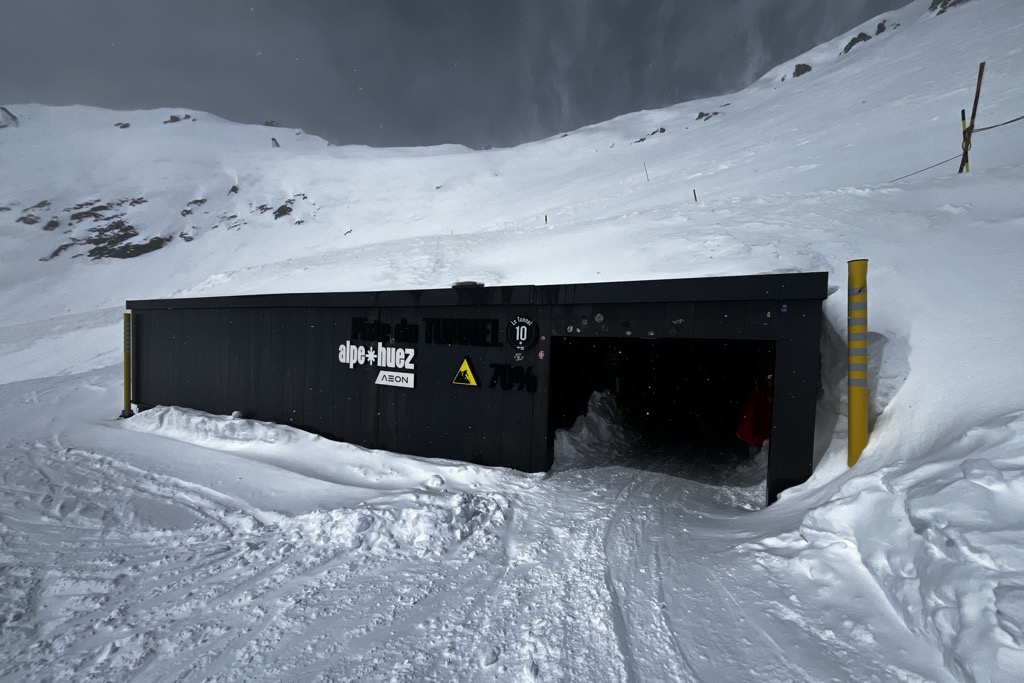
The Tunnel accesses a variety of faces, bowls, small couloirs, and even a marked piste (“Tunnel”). I don’t think they groom this piste very often, if ever, so it will remain deep powder on a powder day. It’s the best way down on a powder day if you get it first. The other option is Brèche, which is marked on the map but is an entirely off-piste descent. All descents lead to the Lac Blanc lift, whose sole purpose is to return skiers to the Pic Blanc cable car. Then, it’s time for another lap.
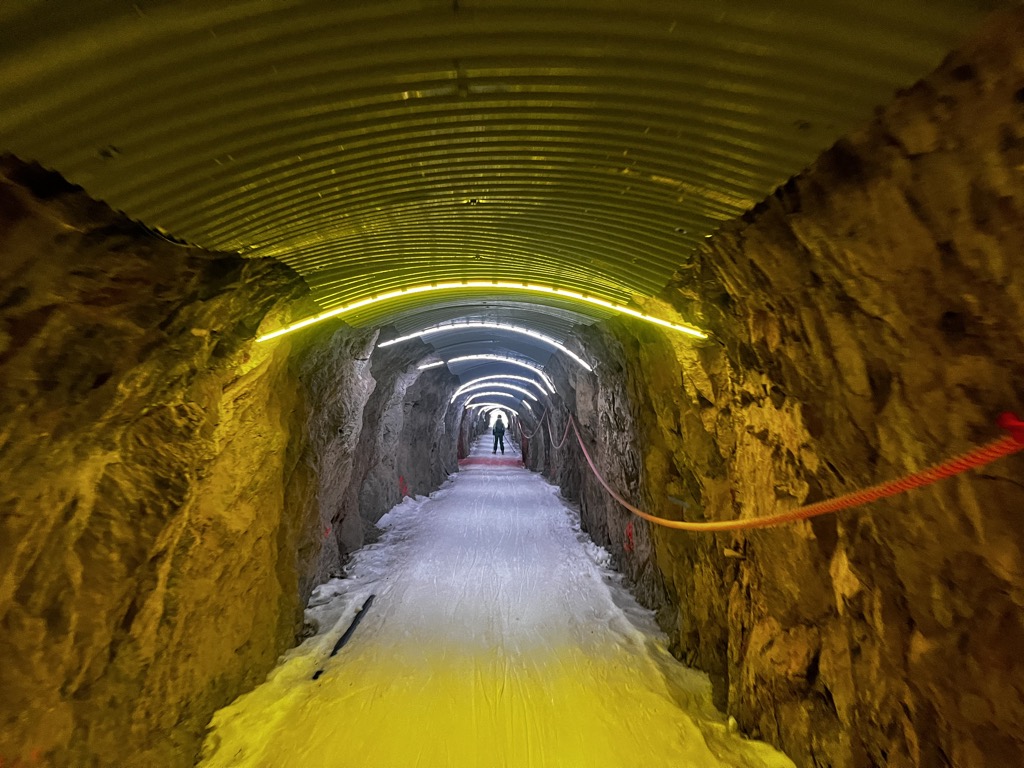
This terrain is steep and playful, but most of the zone is unmarked. Like other parts of Alpe d’Huez, finding the best descents at first can be difficult. Just be patient. Maybe find a local to show you around. Or wait for others to put in tracks. There aren’t many speed fliers, and routes don’t really end in rappels, so you can reasonably follow tracks if you’re an expert skier.
The Tunnel zone faces southwest, so the snow can transform quickly on powder days and form a crust, disrupting the next powder day. Plus, it’s popular, and the main Tunnel descent can get tracked up quickly.
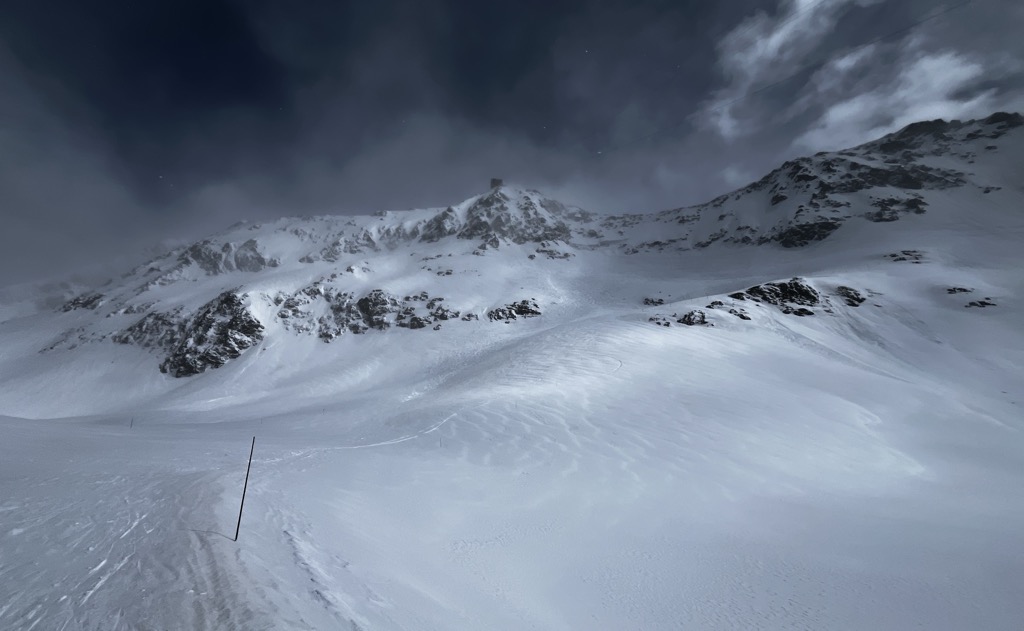
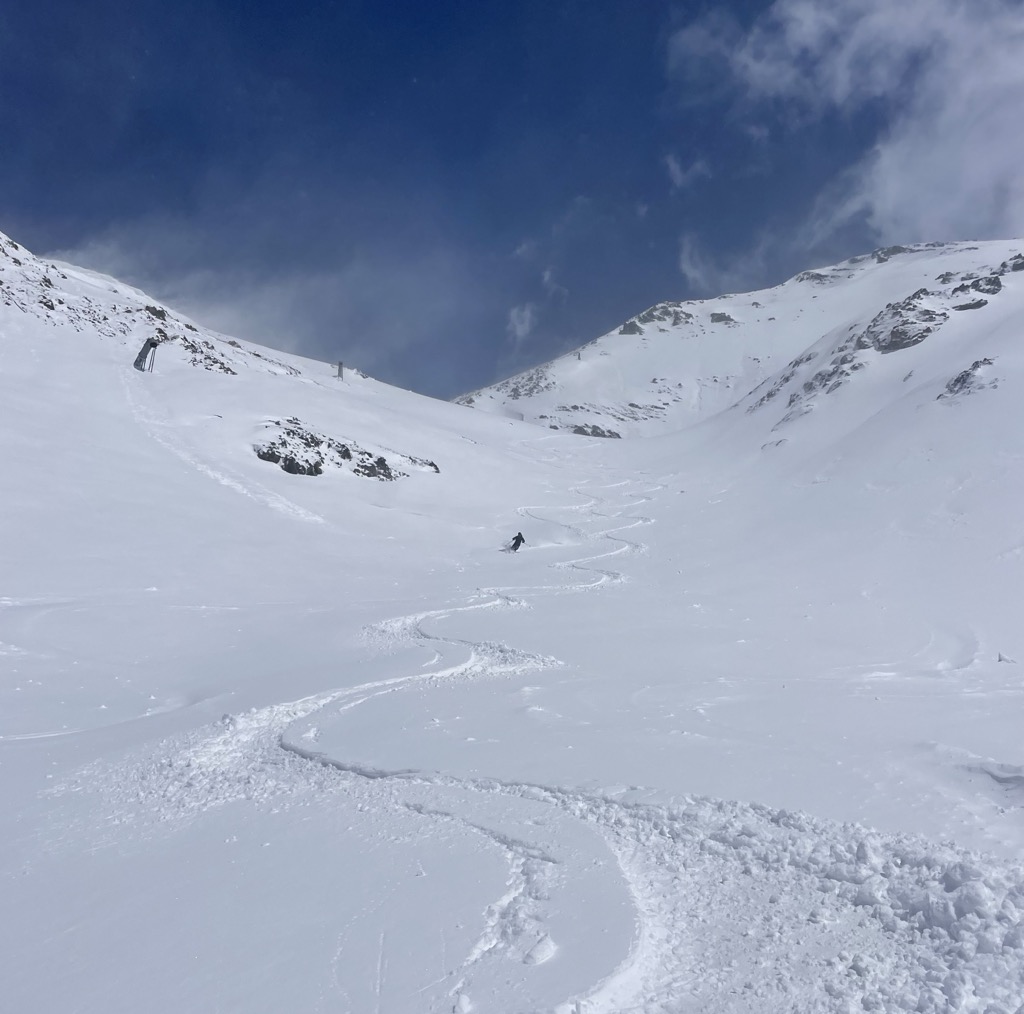
Vaujany is the chicest and most beautiful of the Alpe d’Huez base villages. It’s far less crowded and noisy than the Alpe d’Huez side of the mountain, and you’ll rarely wait in a line at the lifts. There are a variety of easy pistes off the Mont Frais and Clos Giroud lifts, and Vallonets offers some fun off-piste. The problem here is that this terrain is the lowest altitude at Alpe d’Huez and has been seriously snow-challenged these last three years. The black home run that returns to Vaujany, “Fare,” is excellent but not often skiable these days.
However, the aspect is more westerly than on the front side, so the snow can stick around at slightly lower altitudes.
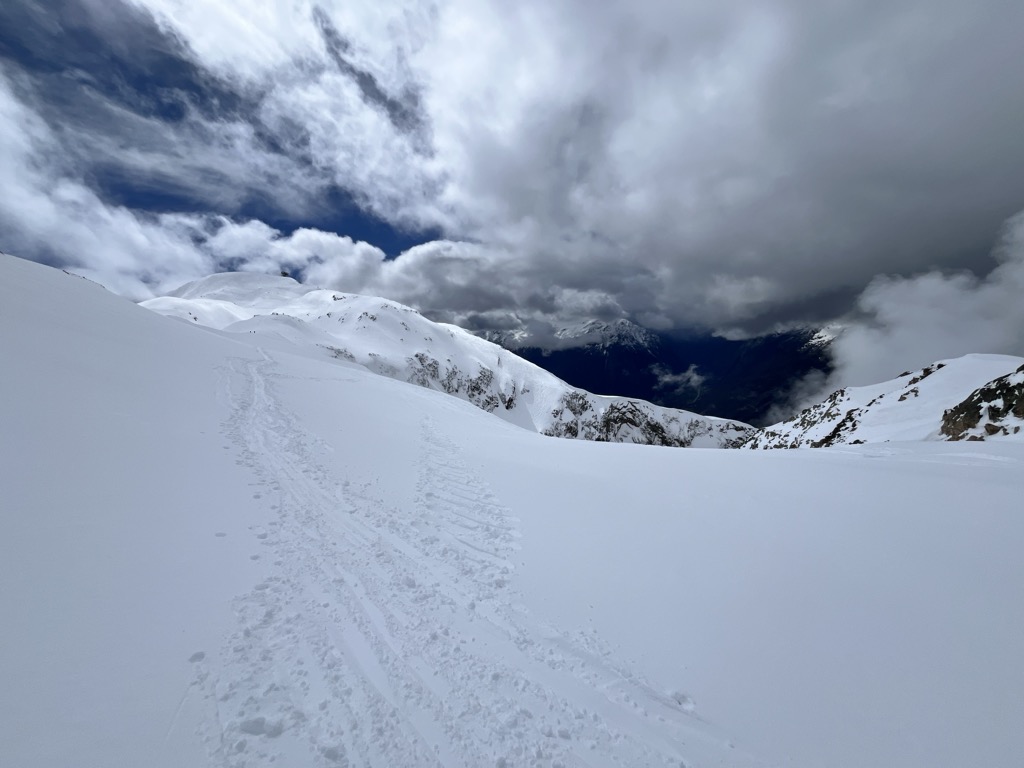
For the best skiing in Vaujany, take the Alpette Rousses cable car to 2800 m (9,186 ft). The cable car services terrain between 2050 and 2800 m. In a new climate regime, you really have to be above 2000 m to consistently find good snow. The cable car accesses two of the mountain’s best red trails, which rip right back to the base, allowing you to do continuous laps.
However, the best feature is the extreme off-piste terrain to the skier’s left at the top of the lift. This zone is simply extraordinary. It gets quite a bit of snow, is avy controlled (to an extent), and holds powder until the afternoon when it starts getting full sun. Just a word of warning: it’s also one of the more extreme lift-access zones where you can ski directly to and from the lift. You really have to know where you’re going because there are cliffs throughout. In fact, most of the zone is staggered cliffs, and it’s all about learning the few routes through. I always wear full avy gear for this area. They control it, but there is still quite a bit of risk, and you must be prepared to self-rescue. Fortunately, Alpe d’Huez also keeps a ski patrol shack right at the top, presumably to respond quickly to accidents in this area as well as the pistes across the way.
The best way to discover this zone is to watch for tracks from the base of the Alpette-Rousses, scout your line from there, and then link it together from the top. You’ll want to have some mountain awareness for this zone because it can get real fast.
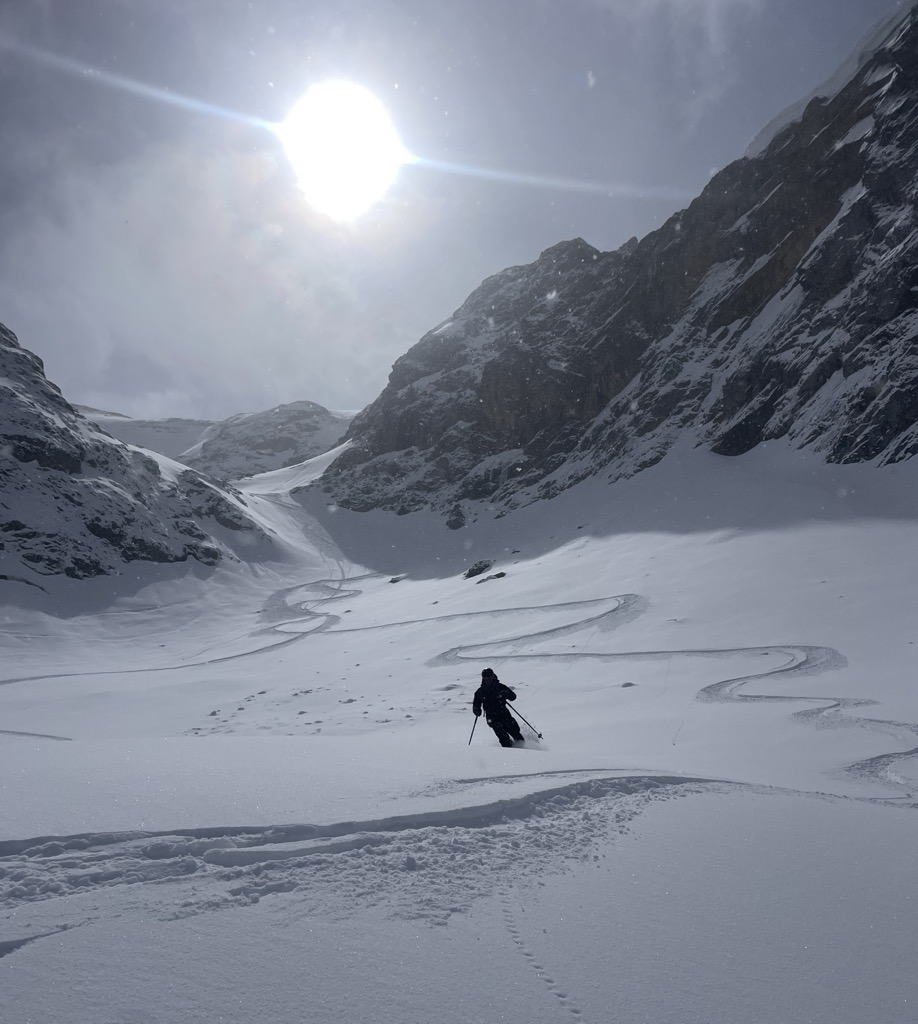
The Signal de l’Homme is yet another outpost of the vast Alpe d’Huez domain that deserves an honorable mention. The zone stretches between the bottom of the Sarenne piste and the base village of Auris. It’s a mixture of pistes and off-piste, with some excellent offerings. It’s one of the few areas with any north-facing terrain, so the snow can stay fresh here, especially in mid-winter when the sun angle is low. It’s hyper-lappable and worth exploring if you’re here for a few days.
The flip side is that it can also get icy while the rest of the mountain is spring skiing. And, not to sound like a broken record, but it’s not quite high enough in this day and age. With more and more rain up to 2000 m, the Signal de l’Homme (~1600 to 2180 meters) can often get skunked.
This refers to the plethora of green and blue pistes that finish around the top of the main base area. The Jeux lift is the primary access to this zone. As far as bunny slopes go, this one stands above the rest. It’s warm, sunny, and offers decent vertical drop for a beginner area.
Alpe d’Huez offers a lot of off-piste skiing but less access to pure backcountry skiing. There are no refuges on the Grandes Rousses massif, and access is lacking, aside from the lifts at the resort. For pure backcountry skiing, as in starting a ski tour without lifts, I recommend the Écrins and Col du Lautaret, which is my home base.
That said, the extreme ski descents from the Pic Blanc lift are the stuff of legend and not to be missed if you’re into that kind of thing.
The descents from the Pic Blanc are fairly serious, and unless you know the area or are an experienced ski mountaineer, you’d be better off hiring a guide. There’s some glaciated terrain, but the primary hazards are avalanches and route-finding. My guide is just a basic introduction because I think the PeakVisor crowd will be intrigued by the possibilities. People have described the routes to me and I’ve done some scouting, but I’ve never done them, so you’ll have to seek out the details elsewhere or scout them for yourself.
The Pic Blanc cable car takes you to the southern tip of the Grandes Rousses Massif, which consists of a north-to-south ridge with several peaks peppered along it. From the cable car, there are two primary descent routes off the sides of this ridge: the Pyramid drops off to the west, while the Glacier du Sablat drops to the east.
The ridge to access these descents is reasonably severe. It’s not a complete knife edge; in the right conditions, you might be able to skin most of it, but there is definitely a risk of cornice failure and avalanche.
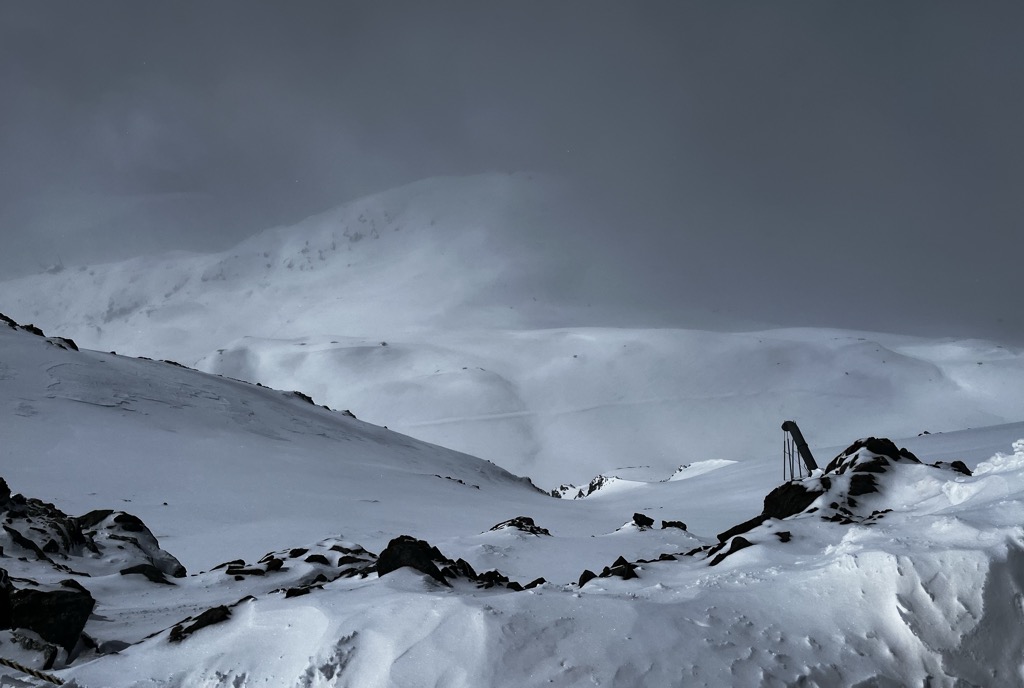
If you head north along the ridge from the cable car, the Pyramid is the next subpeak after Pic Blanc. You can drop east into the large bowl that houses the Sablat or west, where you’ll end up on a large face directly above the Alpette-Rousses off-piste zone I described above. It’s a steep face defined by gnarly cliffs and couloirs; you must know where you’re going. To some extent, you can scout your line from below by venturing out left from the Alpette-Rousses and looking up to your right. I recommend taking a picture to have with you, just in case.
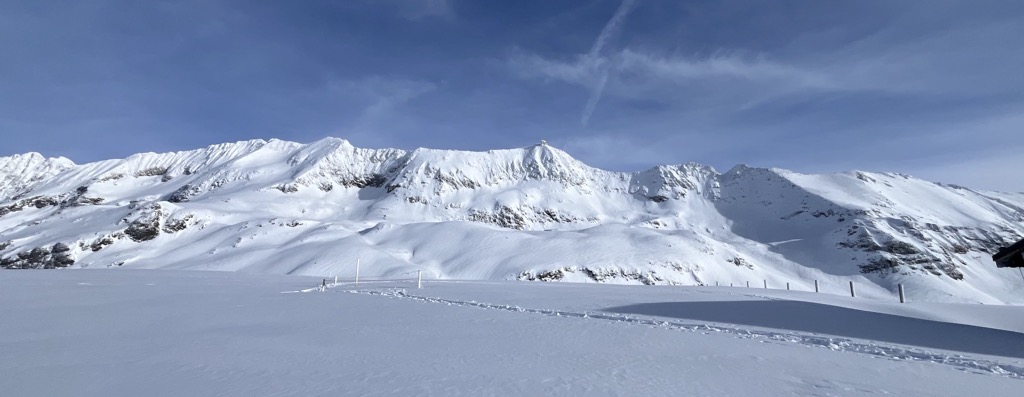
Once you know where you’re going, I don’t think the descent off the Pyramid itself is overly steep. But the ridge traverse, cornice management, route-finding, and avalanche risk above terrain traps make these descents serious. Another issue is that it only comes in condition occasionally, probably in less than 50% of seasons. I know it was in this last season (23-24), but I have never actually seen a track here. Nevertheless, if this were Chamonix, there would be hundreds of tracks. So, there are many opportunities for those seeking to escape the crowds.
Afterward, you will reach the same Alpette-Rousses off-piste zone I mentioned earlier and can ski down to the base of that cable car.
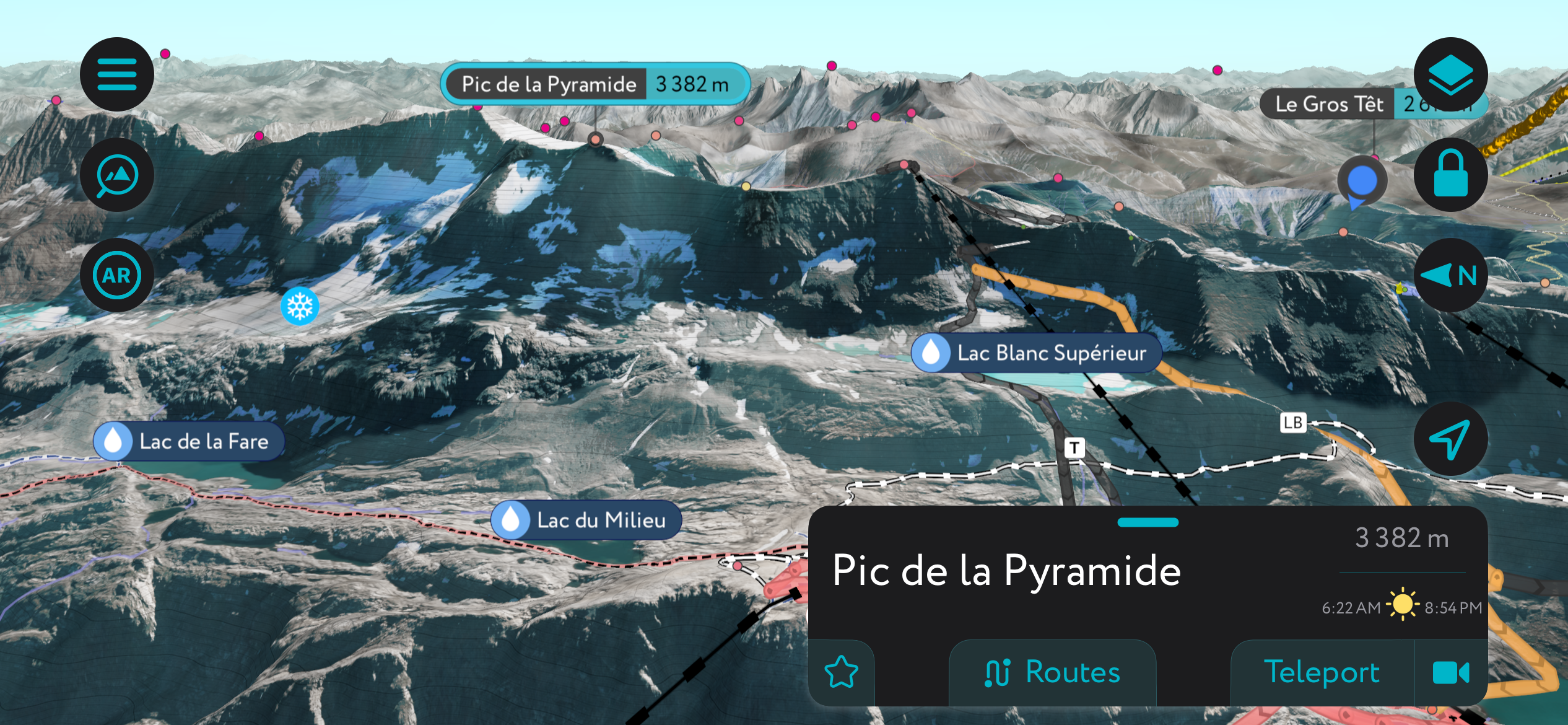
You can start anywhere along the ridge between Pic Blanc and Pic Bayle for this descent. Many people drop in right off the lift rather than navigate the ridge. However, the most aesthetic line, though more exposed, is climbing to the top of Pic Bayle and dropping in from the top of the glacier. Hang to the skier’s right to avoid cliffs.
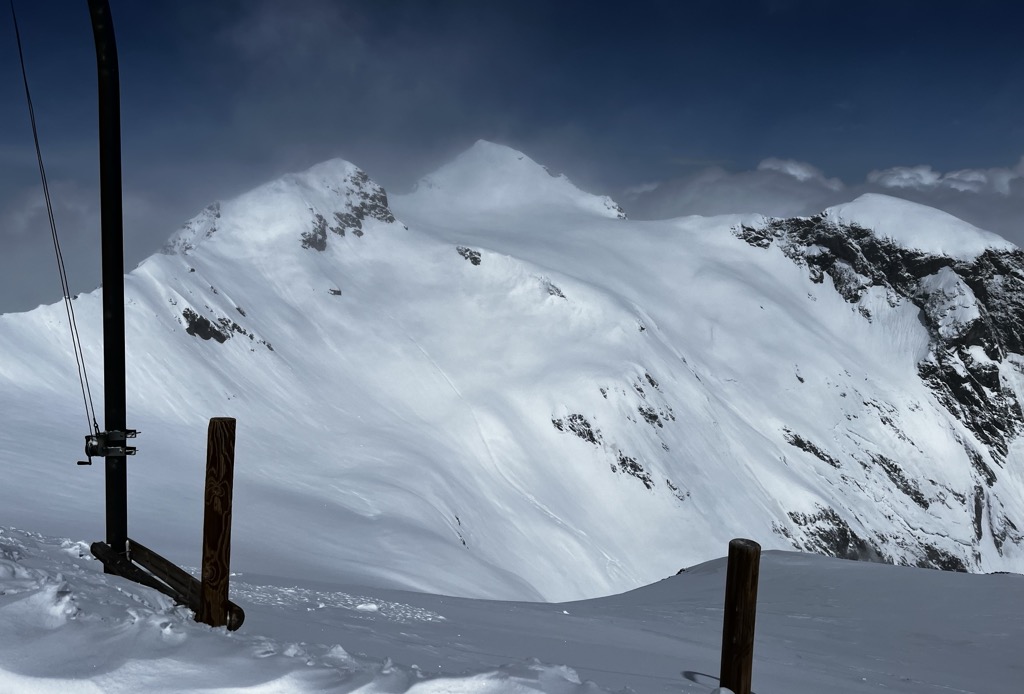
The route becomes less steep as you descend into a broad valley once occupied by the toe of the diminished Glacier du Sablat. From here, there are a couple of options. You can traverse to the skier’s right, following a summer trail. Judging from PeakVisor, I’d say start traversing at ~2,200 meters (7,200 ft). You may need skins for this, though it’s mostly a descending traverse. As an aside, I would always have skins for a route like this, even if you don’t need them for the traverse. Eventually, you’ll reach the final bend of the Sarrenne piste.
You can also descend into the village of Clavans-en-haut, although there’s no reason to do so unless you have a shuttle waiting.
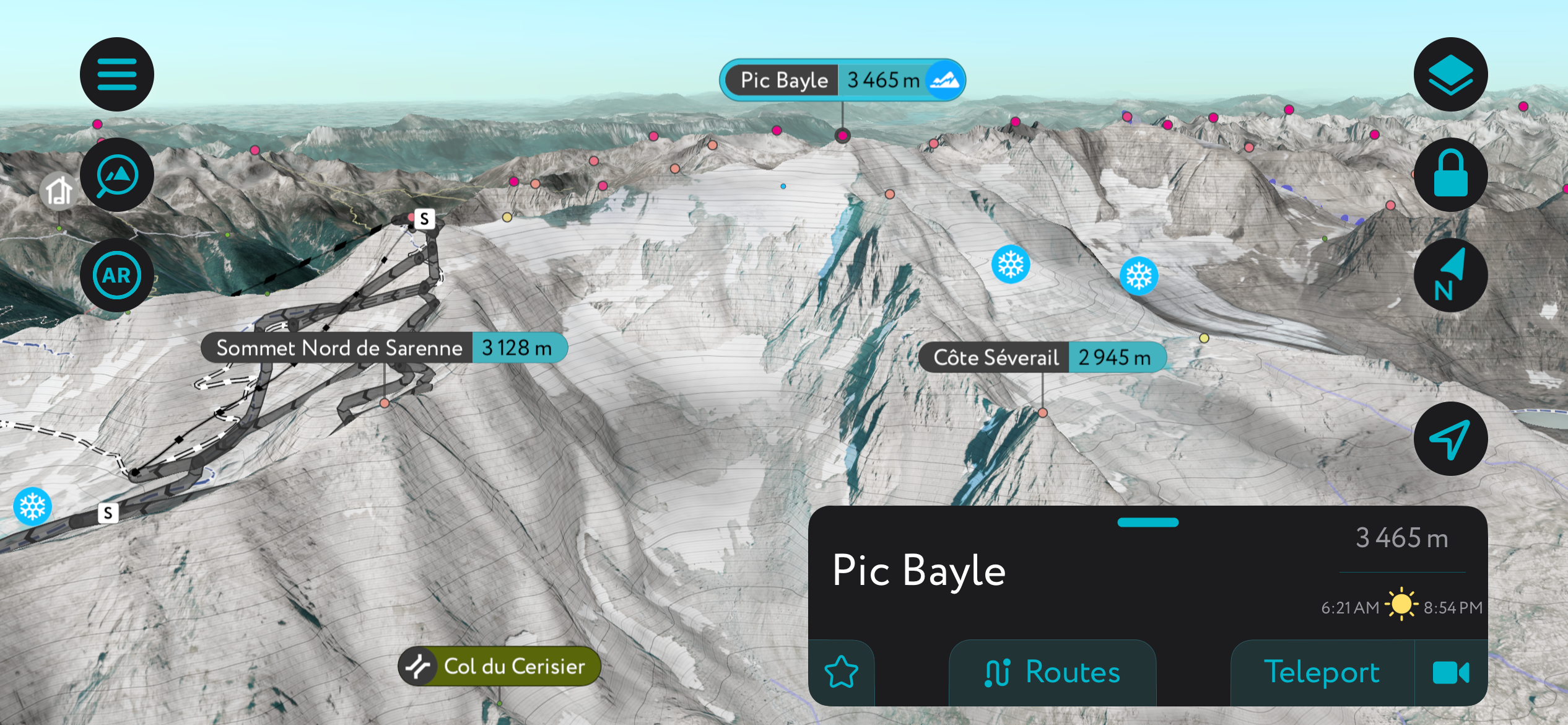
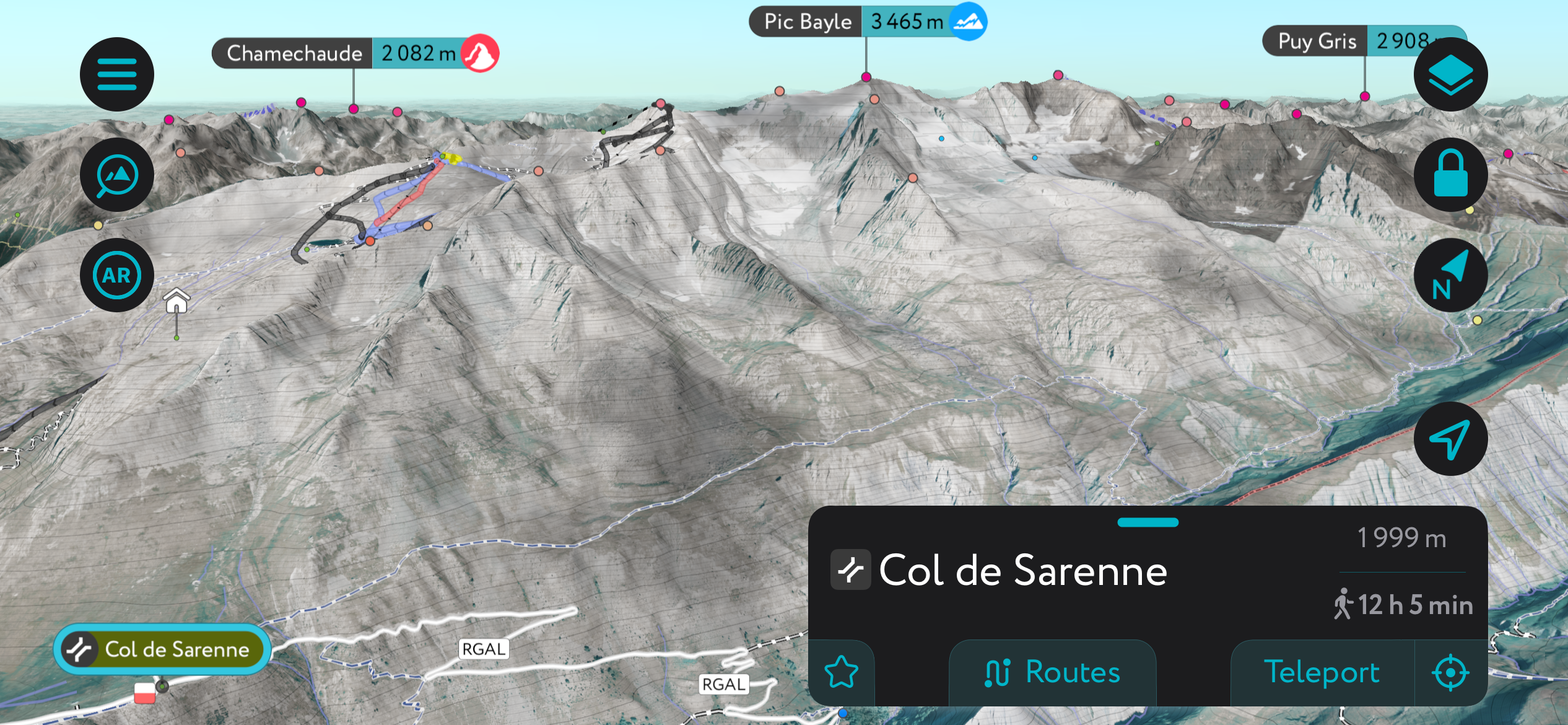
The Col du Lautaret (2,058 m / 6,751 ft) is a mountain pass on the north side of the Parc Nationale des Ecrins on the French 1091 highway. It serves as the main route between Briançon and all points west and offers easy access to a massive diversity of alpine skiing. The top of the pass is about 40 minutes from the village of Montgenèvre.
“The easy road access to such varied all aspects and all level terrain is more than rare. The fact that the touring season stretches from early November to mid-May most years is exceptional”, says Per As, La Grave mountain guide, on why the Col du Lautaret is his favorite place to ski touring.
The terrain is accessible not only from the top of the Col du Lautaret but also from many points to the east and west. The small village of Le Casset is an excellent staging point, and Arsine offers a lifetime of lines and a refuge.
Only some lines are visible from the road. Driving over the col, it may seem like everything is tracked out. The truth is that there are plenty of lines remaining out of sight. Nevertheless, the Col is no secret, and the easy access routes can be littered with people. Undoubtedly, it’s the most crowded backcountry skiing domain in the region. Check out my guide to the Col du Lautaret to learn all you need to know for a first visit!
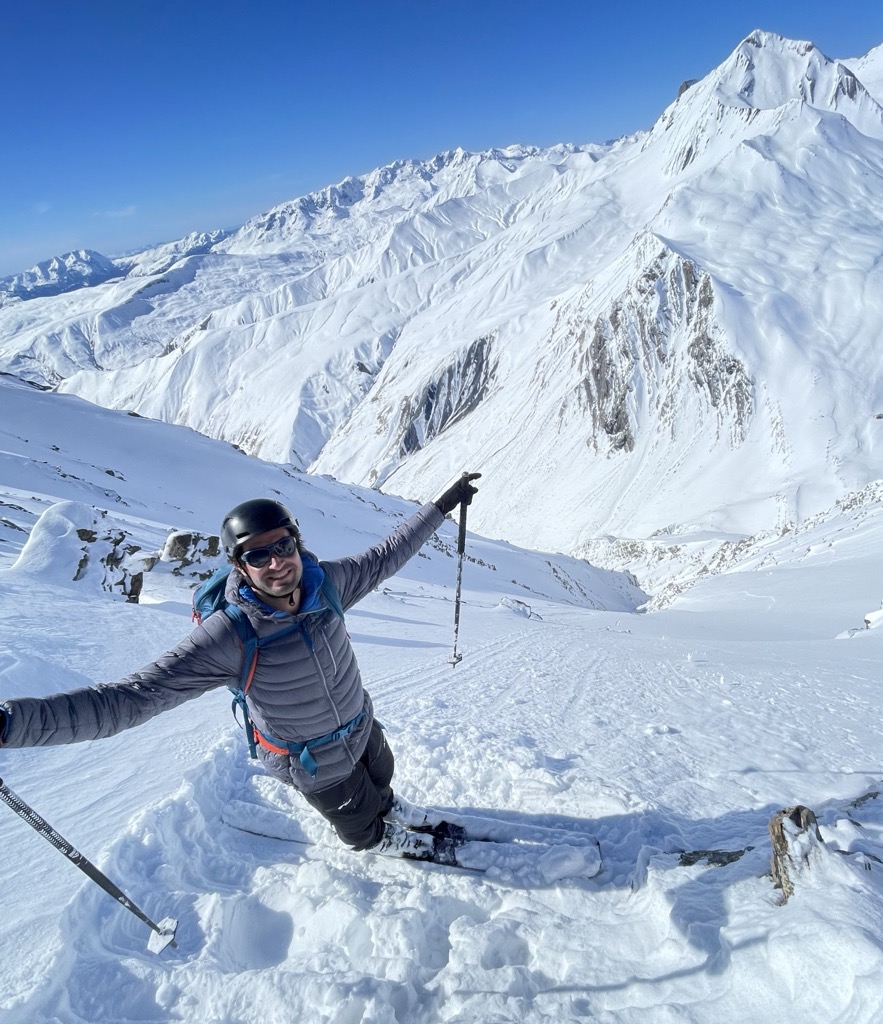
There are several-hundred-page guidebooks for all of the routes in the Écrins; it would take several lifetimes to explore the place entirely. One of the most prized lines is the Dome des Niege (4,015 m / 13,172 ft), a classic ski descent from a 4,000-meter peak, the only one in France outside the Mont Blanc Massif. If conditions are in, you can continue to the Barre des Écrins (4,102 m / 13,458 ft) and ski one of the 50+ degree couloirs from the summit.
All in all, the Écrins is home to many long, strenuous, and delectably remote ski tours. An added advantage of the Écrins over the Grandes Rousses is the blessed presence of dozens of guarded refuges, making long ski tours more accessible. These refuges include the Adèle Planchard, the Refuge des Écrins, and the Refuge d’Aigle.
Check out my recent story about staying at the Refuge d’Aigle and descending the Glacier de l’Homme on the east side of La Meije.
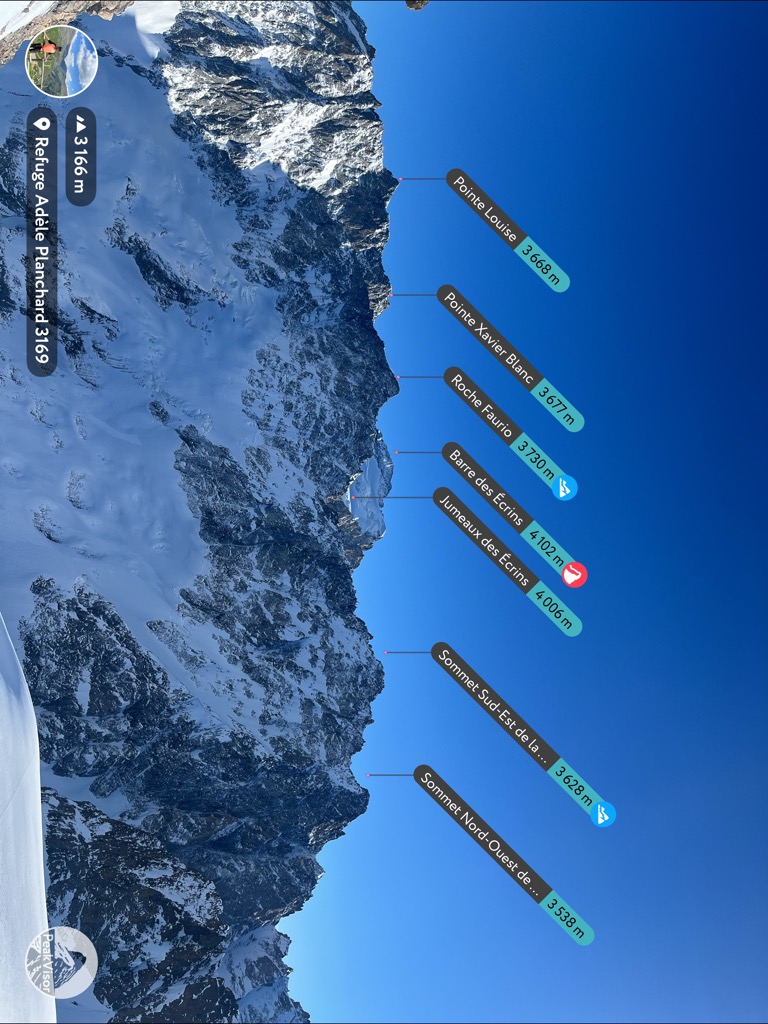
Alpe d’Huez offers more than 20 different pass options on their website. However, I’ll go over the basics here. All prices are for the 23-24 season and will likely increase yearly.
Firstly, remember to bring your rechargeable RFID card so you don’t have to pay the 2€ fee for a new one.
If you show up and walk to the cash register to buy a pass, it’s 59€ during the 23-24 season. This likely increases by 2-3 euros a year.
You can save money by buying in bulk. For example, a six-day consecutive pass is 244€, or just 40€ per day. A non-consecutive ten-day pass is 510€, or a daily savings of 8€.
Lastly, prospective long-term visitors can obtain a season pass for just 720€ if they buy early, although this goes up to 1,052€ after November 20.
Like most French mountain destinations, Alpe d’Huez maintains an excellent tourist office:
Alpe d’Huez Tourist Office
Place Joseph Paganon
38750 Alpe d'Huez
Telephone : 04 76 11 44 44
e-mail : info@alpedhuez.com
Website : https://www.alpedhuez.com
Facebook page : https://www.facebook.com/alpe.huez
I haven’t spent much time dining at Alpe d’Huez, especially for dinner. Therefore, Google is likely to be a better aide than my advice.
However, I do get lunch here from time to time, especially in the summer, and I always go to one place: Captain Sandwich. It’s fast, cheap, and delicious. The menu features a long list of tasty sandwiches and other treats, and it’s right off the green slope that cuts through the middle of the main base village.
Captain Sandwich
Address: 279 Av. des Jeux, 38750 Huez
Phone: 04 76 79 12 47
Most of the restaurants conform to your standard French bistro format. I’ve also sampled a few of these, and none of them have disappointed. The prices are humane, and the food is decent for France…and incredible if you’re coming from America, England, or Germany.
The après scene here rages. You could spend every night for five months getting hammered at one of the dozens of bars in the main base village. However, the other villages are tranquil, with little nightlife, so if you want peace and solitude, you can find that too.
Over the past decade, La Folie Douce has become France's most Instagrammable après scene. Having started in Val d’Isère, it now has locations at eight different resorts. At Alpe d’Huez, it’s located on the slopes, next to the mid-station at Marmottes 2.
Like an exclusive club, La Folie Douce increases its demand by playing hard-to-get. There’s always an enormous crowd waiting to be served, and the food and drinks are outrageously expensive. It’s just the place to be seen, I suppose. If you’re the type of Alpe d’Huez visitor who has made it this far in the article, I doubt you have much interest in La Folie Douce.
They frequently have DJ sets and parties outdoors, and since this side of Alpe d’Huez is south-facing, it can be lovely in the afternoon. The bar opens around 2:30 p.m. and continues until the lifts close (4:30 p.m.), at which point you must download or ski down.
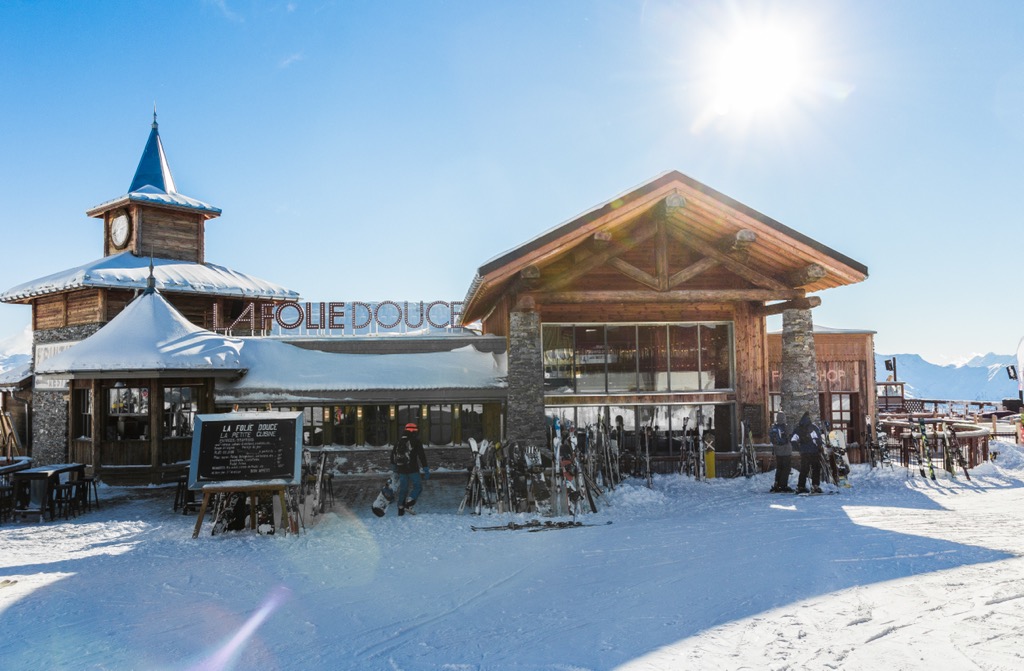
Smithy’s Tavern and the Underground Bar are the most popular for English-speaking tourists, namely the British. Yes, the Underground borrows its logo from the London subway. Smithy’s dubs its cuisine “Tex-mex steakhouse,” which is a bit cringe for an American ex-pat living in France.
There’s always plenty of music and goings-on throughout the winter, especially at the Underground. These are dive bars, though, with sticky floors and lots of stuff on the walls. If you’re looking for a place to hang out late, these spots are open until 2 a.m. most nights.
For something swankier, check out the lounges of the various hotels. The Daria-I Nor is a bit removed from the main village area and has a luxurious bar and lounge with an exotic, artsy vibe.
Since its inception in Belgium in 2005, Tomorrowland has grown into one of the world's largest and most profitable electronic music festivals. Over 70,000 people attend the festival each summer; it’s no surprise they decided to produce a winter version. It is a surprise that it’s in Alpe d’Huez, though. Each of the last several winters in mid-March, 25,000 people have descended upon the resort to rage their faces off for seven days and nights straight (that’s right, it’s a whole week, so you have to pace yourself). It’s been a boon to Alpe d’Huez’s economy; everything gets super expensive during this time.
There’s a main stage located right below the base of the Marmottes lift system. As I understand it, they also set up stages across the mountain so you can ski around and listen to music during the day. It doesn’t stop until the wee hours of the morning. Steve Aoki headlined this year to give you an idea of the size of the artists coming here. I wouldn’t say it’s my favorite brand of electro music, but it floats a lot of other people’s boats.
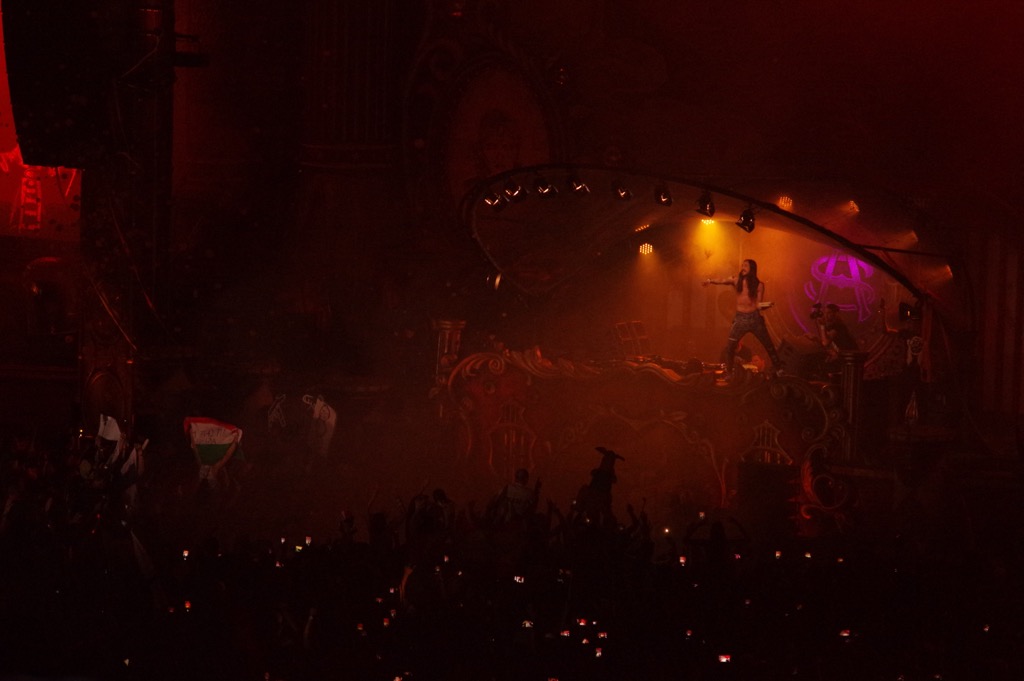
One of the best things about Alpe d’Huez is all the great ski resorts within spitting distance. The first two on this list, Les 2 Alpes and La Grave, are owned by the same company as Alpe d’Huez and can be combined with certain types of passes (see website).
Les Deux Alpes, located on the west aspect of the Meije Massif, is a massive and renowned megaresort that attracts millions of visitors every year. It’s the brother of Alpe d’Huez; they’re both big megaresorts with great terrain if you know where to look. They’re also owned and operated by the same company, Aeon.
Les 2 Alpes offers a vast ski area spanning altitudes from 1,300 to 3,600 meters, with the top connectable to nearby La Grave by a short hike. The glacier, one of the largest skiable glaciers in Europe, ensures excellent snow conditions throughout the year. These guys have one of Europe's longest summer ski seasons, although that is sadly changing.
Beyond its extensive terrain, Les Deux Alpes boasts an uproarious après-ski scene (full of Brits) and a variety of off-slope activities. Like Alpe d’Huez, the resort offers plenty of luxury wellness facilities, such as spas and thermal baths.
Les 2 Alpes is too crowded and hectic for my taste. Somehow, Alpe d’Huez always seems more relaxed even though they both cater to many thousands of skiers each day. However, summers here are incredible, with the ski lifts remaining operational to serve a network of finely sculpted bike trails.
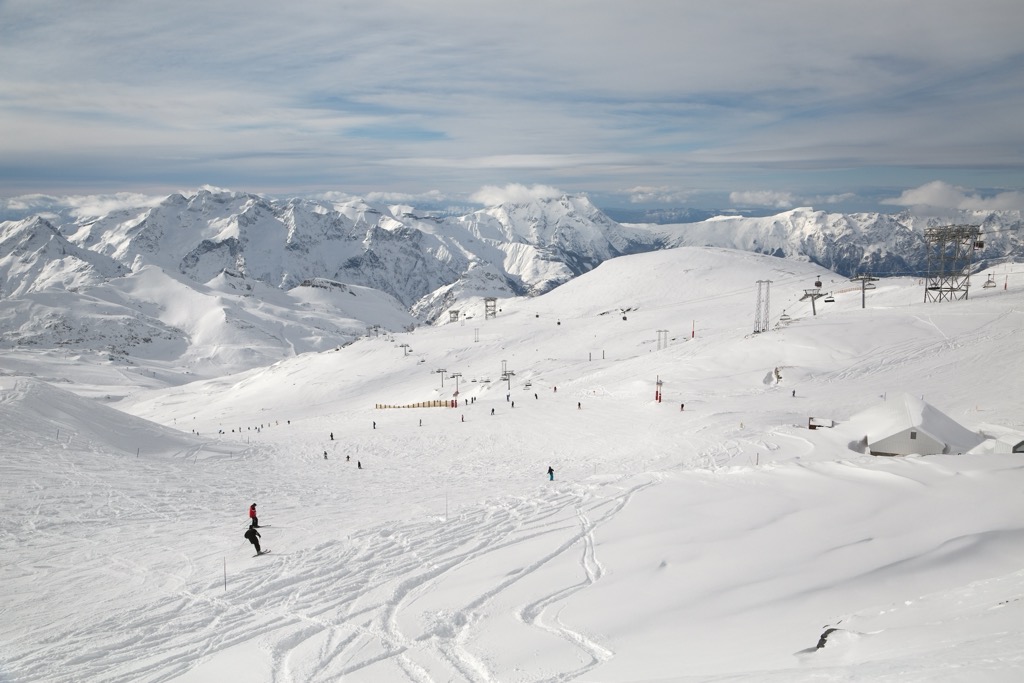
La Grave is my home and my favorite ski area in the world. The sleepy cluster of villages known as La Grave is perched in a deep valley that demarcates the north end of the Parc National des Écrins. There is one lift, ‘the Téléphérique,’ to 3200 m (10,500 ft), and another drag lift to 3600 m (11,811 ft). No trails exist on the mountain; every descent is off-piste and requires a high level of skiing and route-finding. Here, we trade groomed, manufactured runs for natural features such as couloirs, bowls, and faces.
The Téléphérique was constructed in the ‘70s, allowing hikers to go up and look around at the Glaciers de la Meije and boost the economy. In the ‘80s, pioneers began exploring the steep slopes on skis. The ‘90s and ‘00s saw a popularization of extreme skiing and increased traffic in La Grave. Yet, the village remains authentic, and the slopes are still relatively empty.
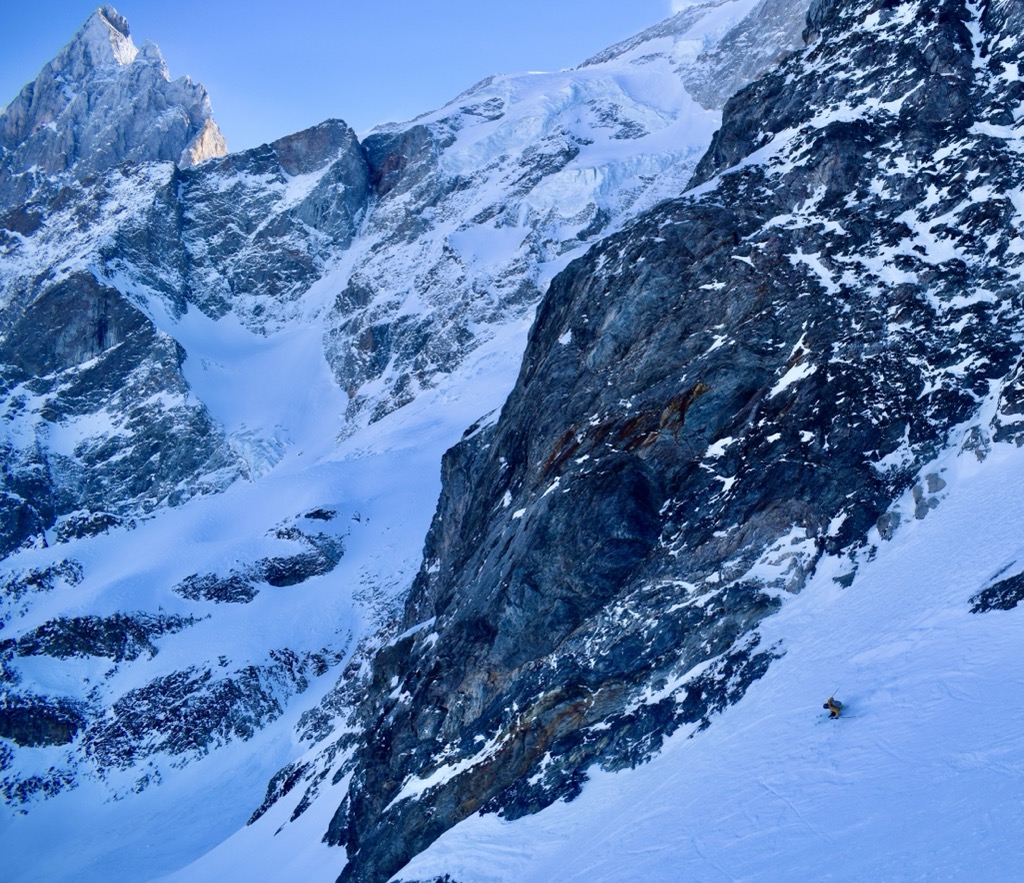
La Grave is a land of extremes. First, there's the ski terrain, much of which could be considered extreme. However, I believe the spectrum of possible experiences here defines La Grave’s extreme-ness. At a ski area that has less than 100 skiers most days, you might wait in line for hours at the inefficient lift on a March powder day. While temperatures on the glacier can often threaten frostbite in minutes, I’ve never sweated so hard while skiing as I do while threading my way down 2000 vertical meters of off-piste. I’ve skied the best and worst terrain of my life and had the best and worst snow conditions of my life (sometimes on the same run). Most of the time, La Meije shows us her infinite love. But sometimes, she is trying to kill us.
No luxury accommodations exist in La Grave, and there are no nightclubs or cinemas. The village offers little but a few restaurants, gear shops, hotels, and a small market. Even the slightest injury on the mountain necessitates a helicopter rescue if you cannot ski down. It’s not everybody’s cup of tea, but this place rules for those serious about their skiing.
Serre Chevalier Ski Area offers wide pistes, freeriding itineraries, hike-to terrain, and a lift system stretching over several peaks. Serre Chevalier is tasteful, relaxed, full of great restaurants, and altogether more enjoyable than Les 2 Alps.
The resort comprises several base villages, including Briançon, Chantemerle, Villeneuve-la-Salle, and Le Monêtier-les-Bains. It is the largest ski resort in Provence-Alpes-Côte D'Azur, with more than 250 km (155 mi) of slopes and more than 60 ski lifts, which reach 2,800 m (9,186 ft). The tree skiing amongst ancient larch forests is enchanted. It’s some of the best in Europe when there is snow.
Speaking of snow, there’s usually plenty of it. Serre Chevalier gets storms from multiple directions. They also have extensive snowmaking on the pistes. Another aspect of Serre Che is the access from Briançon, which is unique among European ski towns. The historical Old Town dates back 400 years. The restaurants and accommodation are affordable. There’s none of the glitz and glam of other ski resorts — all of that exists in the other base villages. Briançon is a bit rough around the edges in a way that I appreciate.
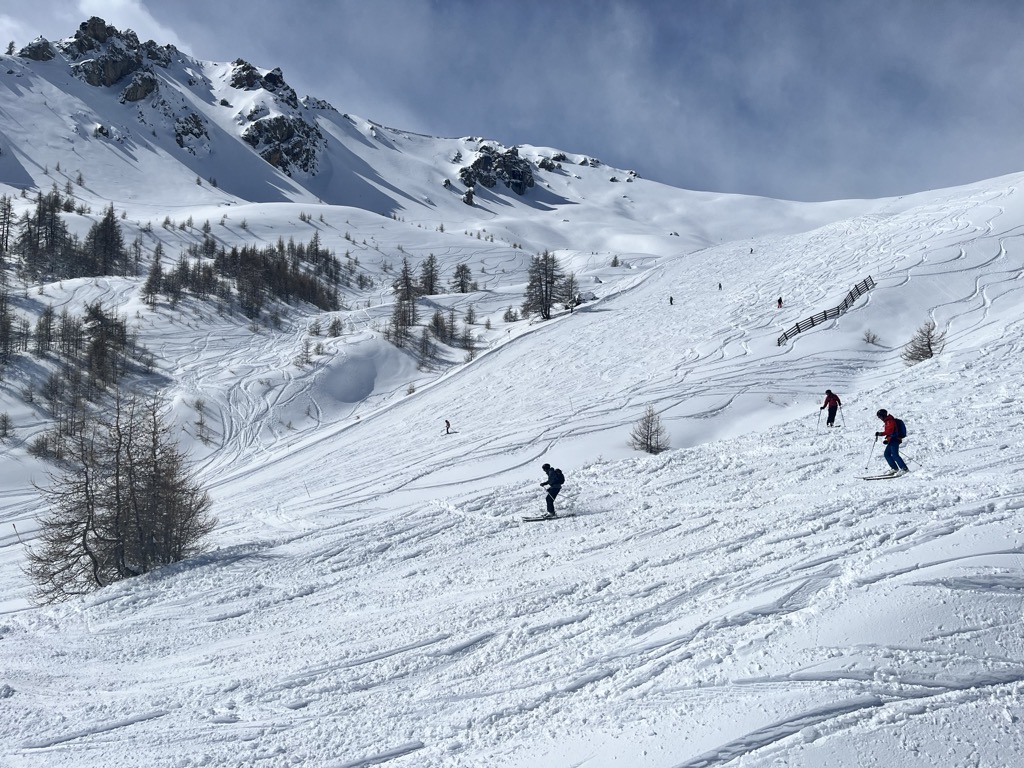
Les 7 Laux is a popular ski resort in the Belledonne mountain range of the French Alps, near the town of Goncelin in the Isère department. As the crow flies, it’s close to Alpe d’Huez, likely just a few kilometers from the Vaujany side. However, driving from one to the other would take longer.
It’s a big resort with over 120 km of pistes across three interconnected areas. The Belledonne Massif gets pounded by storms from the west and northwest, so there can also be big powder days here. I haven’t skied at Les 7 Laux, but I’m betting the terrain is good. I’ve never been to a French ski resort with bad terrain; the Alpes are just too steep for the skiing to be boring.
The problem with Les 7 Laux is its elevation. It only reaches 2400 m (7874 ft), which is insufficient to offer consistent good snow nowadays. However, it is better than the neighboring Chamrousse, which only reaches 2000 m (6,600 ft). It’s my understanding these resorts are popular with the Grenoblois crowd. After all, Grenoble markets itself as “le capital des Alpes.” A friend who works for the tourist office in Les 2 Alpes told me that Alpe d’Huez and 2 Alpes are getting more crowded because the lower-elevation ski resorts closer to the city don’t get snow anymore. People are forced to go higher and higher.
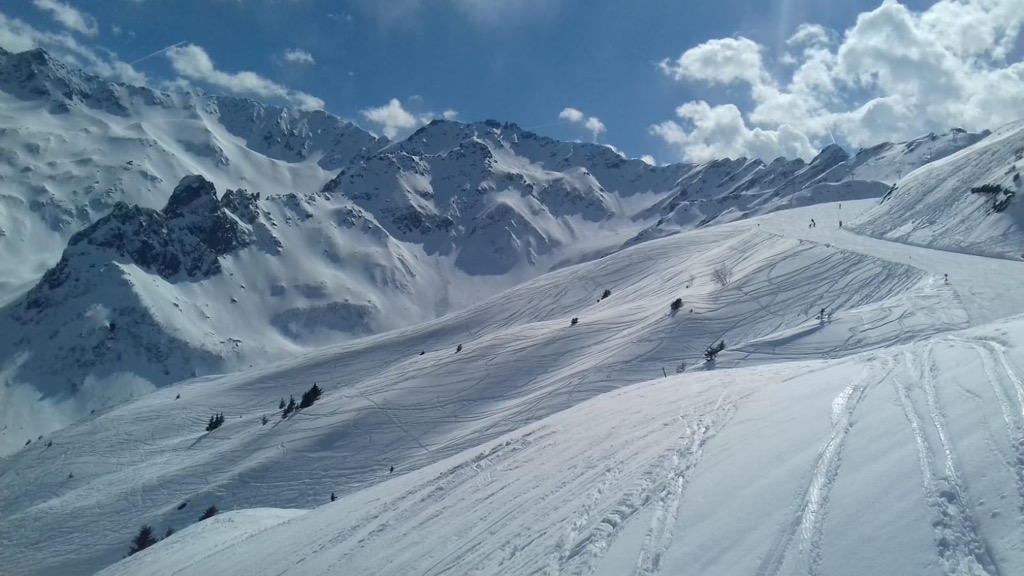
If you visit Alpe d’Huez, you will likely pass through Grenoble. While not the most beautiful French city, Grenoble has a certain charm, and it’s worth spending a day here to experience the vibe.
The city has an intellectual atmosphere due to its status as an academic research hub. There are also plenty of artists, musicians, and bohemian culture. Grenoble has a great music scene for a medium-sized city. Restaurants of every sort - not just French cuisine - are clustered throughout the downtown. In the winter, it can feel like a massive ski town; walking around the city at dinner time, you’ll see scores of skiers returning home to their apartments from a day at the slopes.
You can also access the resort using public transportation. Buses leave the Gare de Grenoble several times a day.
